Idaho is home to an incredible variety of birds, with over 350 species having been recorded in the state. From the colorful and iconic Bald Eagle to the elusive and secretive Flammulated Owl, Idaho’s bird life is as diverse as its ecosystems.
From the lush forests of the north to the sagebrush deserts of the south, Idaho is the perfect place for birders to explore and discover the unique species found in the region.
This guide will provide an overview of the birds of Idaho, including their habitats, populations, and conservation status.
1. House Finch

The House Finch is a species of finch native to western North America and has been introduced in the eastern half of the continent as well as Hawaii.
It’s an average-sized finch with adults measuring 12.5 – 15 cm (5 – 6 inches) long and having wingspans between 20 – 25 cm (8 – 10 inches).
The upperparts are brown, while its underparts range from pale grayish white to yellow depending on subspecies.
Its face is streaked or spotted with reddish coloration; males typically have brighter plumage than females due to sexual dimorphism.
They’re mostly found near human habitations such as farms and gardens where they feed on grains, fruits, insects, etc., making them very popular among birders who want something colorful for their backyard.
Scientific classification:
| Kingdom | Animalia |
| Phylum | Chordata |
| Class | Aves |
| Order | Passeriformes |
| Family | Fringillidae |
| Subfamily | Carduelinae |
| Genus | Haemorhous |
| Species | H. mexicanus |
2. American Robin

The American robin is a migratory bird, belonging to the true thrush genus and Turdidae family.
It was named after its European counterpart due to the similar reddish-orange breast they both possess; however, they are not related closely.
This species can be seen through most of North America during winter months, as well as in parts of Mexico and Central America where it also breeds.
They have plump bodies with gray upperparts and white underparts that vary from yellow on their throats down to orange toward their bellies.
Robins feed on fruits such as berries or insects like worms which makes them an important part of ecosystems by helping disperse seeds naturally throughout these areas.
Scientific classification:
| Kingdom | Animalia |
| Phylum | Chordata |
| Class | Aves |
| Order | Passeriformes |
| Family | Turdidae |
| Genus | Turdus |
| Species | T. migratorius |
3. American Goldfinch
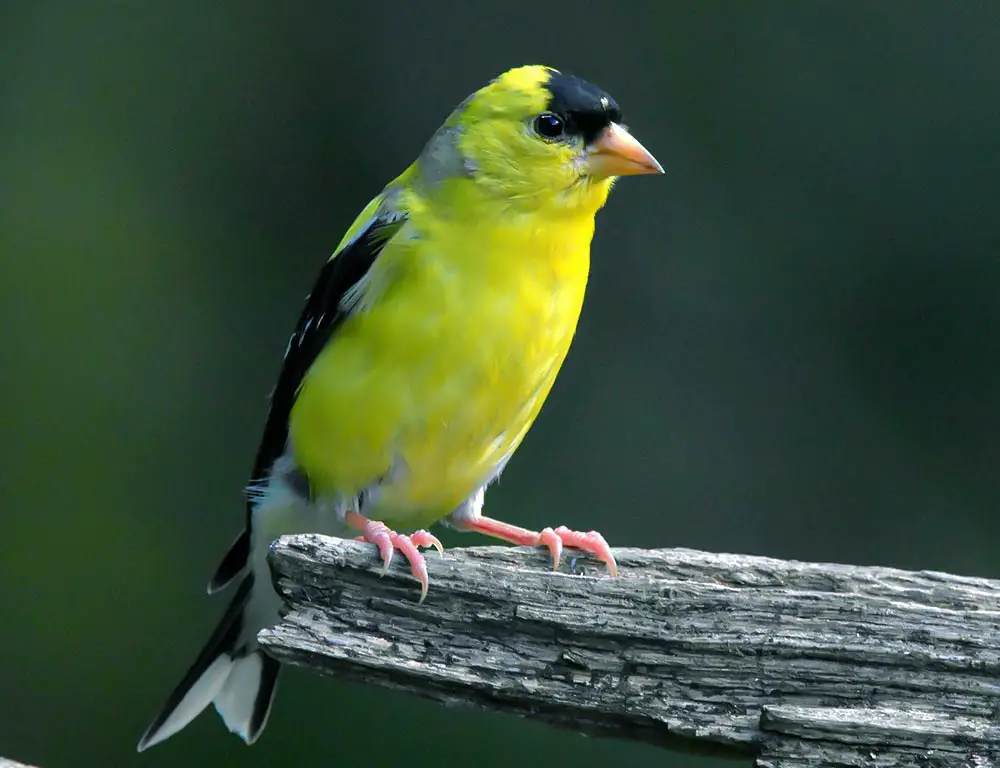
The American goldfinch is a small North American bird in the finch family. Males are vibrant yellow with black wings and tails, while females are duller in coloration.
It migrates from mid-Alberta to North Carolina during the breeding season, south of Canada–United States border to Mexico for its wintering grounds.
The only finch that undergoes complete molt every year, it displays sexual dichromatism where males have brighter colors than their female counterparts.
They feed mainly on seeds but also eat insects such as aphids and caterpillars when raising young; they often occur near thistles or other plants that produce viable seed heads.
Their call consists of an array of chirps and trills making them quite conspicuous.
Scientific classification:
| Kingdom | Animalia |
| Phylum | Chordata |
| Class | Aves |
| Order | Passeriformes |
| Family | Fringillidae |
| Subfamily | Carduelinae |
| Genus | Spinus |
| Species | S. tristis |
4. Common Starling

The Common Starling is a medium-sized passerine bird that belongs to the Starling family. It has glossy black plumage with a metallic sheen, and at certain times of the year, it can be speckled with white.
The bill and legs are typically pink or black depending on the season, while its length measures about 8 inches long.
Its diet consists mainly of insects but also includes small fruits and seeds as well as some human food waste.
They live in large flocks which protects predators, although they can become quite aggressive when defending their nesting sites during breeding seasons.
Overall, this species is highly adaptable and widely distributed across many parts of Europe making them one of the most successful birds in the region today.
Scientific classification:
| Kingdom | Animalia |
| Phylum | Chordata |
| Class | Aves |
| Order | Passeriformes |
| Family | Sturnidae |
| Genus | Sturnus |
| Species | S. vulgaris |
5. Red-Winged Blackbird

The red-winged blackbird is a beautiful bird found in most of North America and Central America.
Its distinct features include a glossy black body, with white shoulder patches and bright red wing coverts year round.
It prefers wetland habitats such as marshes, ponds, lakeshores, and agricultural fields. During breeding season they inhabit grassy areas near water then move south for the winter months.
For food, they mainly eat insects but also consume wild fruit or grains.
They are very social birds often seen in large flocks during migration times when their unmistakable “conk-la-ree” call can be heard echoing across the sky.
Scientific classification:
| Kingdom | Animalia |
| Phylum | Chordata |
| Class | Aves |
| Order | Passeriformes |
| Family | Icteridae |
| Genus | Agelaius |
| Species | A. phoeniceus |
6. Thrush
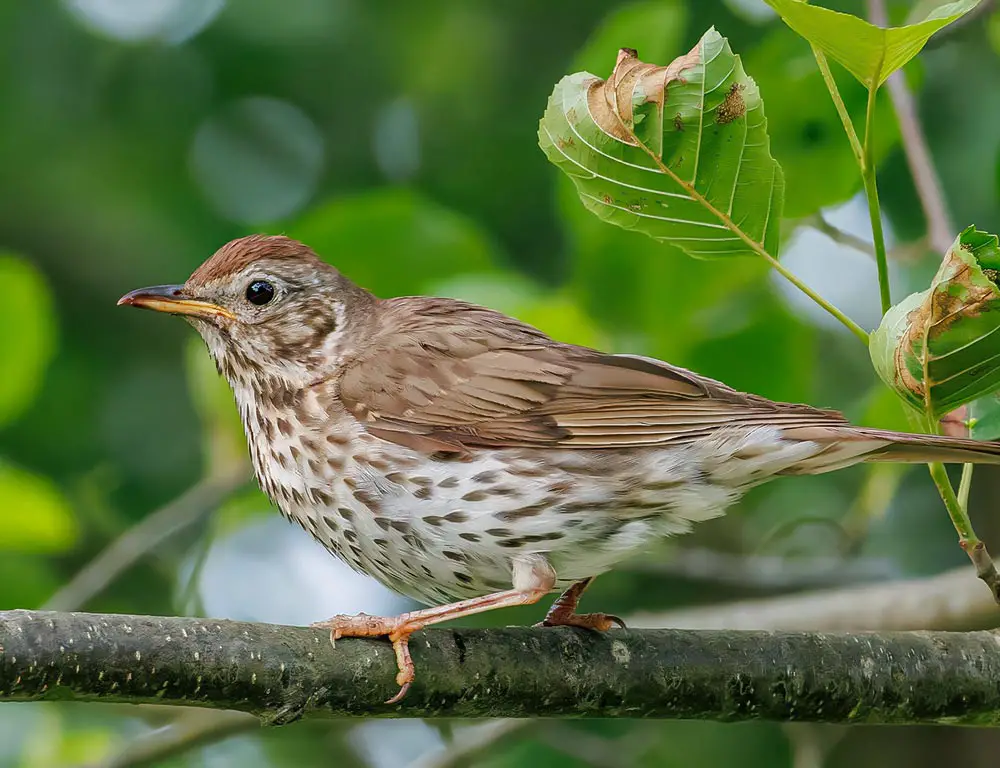
Thrushes are small to medium-sized birds belonging to the Turdidae family and found all over the world. They live on or near the ground and feed on insects, other invertebrates, and fruit.
Their feathers range from greyish browns to deep blues in color with spotted wings that help them blend into their natural habitats such as forests, woodlands, and shrubs.
Thrushes have distinctive songs that they sing during spring mating season; many species also perform complex flight displays for courtship rituals.
These birds may be solitary creatures but can often be seen foraging together in groups or pairs when searching for food sources like worms, snails, or berries.
A healthy thrush population is an indication of a balanced environment since they require clean water sources as well as plenty of vegetation cover – making them important indicators of ecosystem health worldwide.
Scientific classification:
| Kingdom | Animalia |
| Phylum | Chordata |
| Class | Aves |
| Order | Passeriformes |
| Suborder | Passeri |
| Family | Turdidae Rafinesque, 1815 |
7. Song Sparrow

The Song Sparrow (Melospiza melodia) is a small, yet abundant bird found in North America.
They have brown upperparts with dark streaks and are white underneath, complete with a distinct dark brown spot on the breast.
Their cap is also brown and long roughed feathers can be seen sprouting from their neck area.
This sparrow species is highly variable and adaptable to many different environments including dry brush land, wetlands, or open fields.
It has been noted that adult song sparrows will sing even during winter months when other birds remain quiet.
These energetic little animals make for great backyard companions as they flit about singing their lovely melodies.
Scientific classification:
| Kingdom | Animalia |
| Phylum | Chordata |
| Class | Aves |
| Order | Passeriformes |
| Family | Passerellidae |
| Genus | Melospiza |
| Species | M. melodia |
8. Black-Billed Magpie
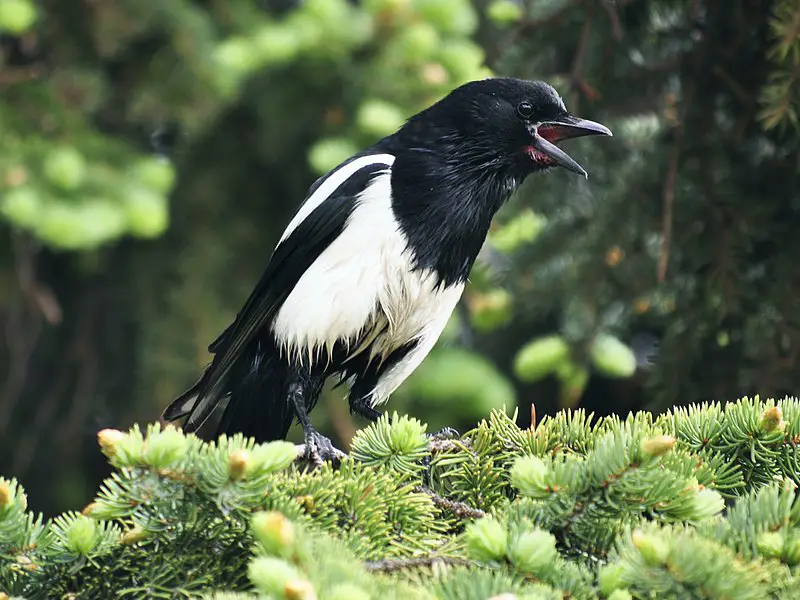
The black-billed magpie is an iconic bird of the western half of North America and one of only four songbirds with a tail that makes up over half its body length.
With its glossy black feathers offset by white patches, they can be seen in open woodlands or near agricultural areas.
Their diet consists mainly of insects, carrion, and grains but they often scavenge human food as well.
They are highly social birds who live in large groups and communicate through loud calls, snaps, and rattles when defending their territory from other airborne predators like hawks or eagles.
Magpies have proven to be hardy survivors despite habitat loss due to urbanization so there’s hope these remarkable birds will remain part of our landscape for many years to come.
Scientific classification:
| Kingdom | Animalia |
| Phylum | Chordata |
| Class | Aves |
| Order | Passeriformes |
| Family | Corvidae |
| Genus | Pica |
| Species | P. hudsonia |
9. Mourning Dove
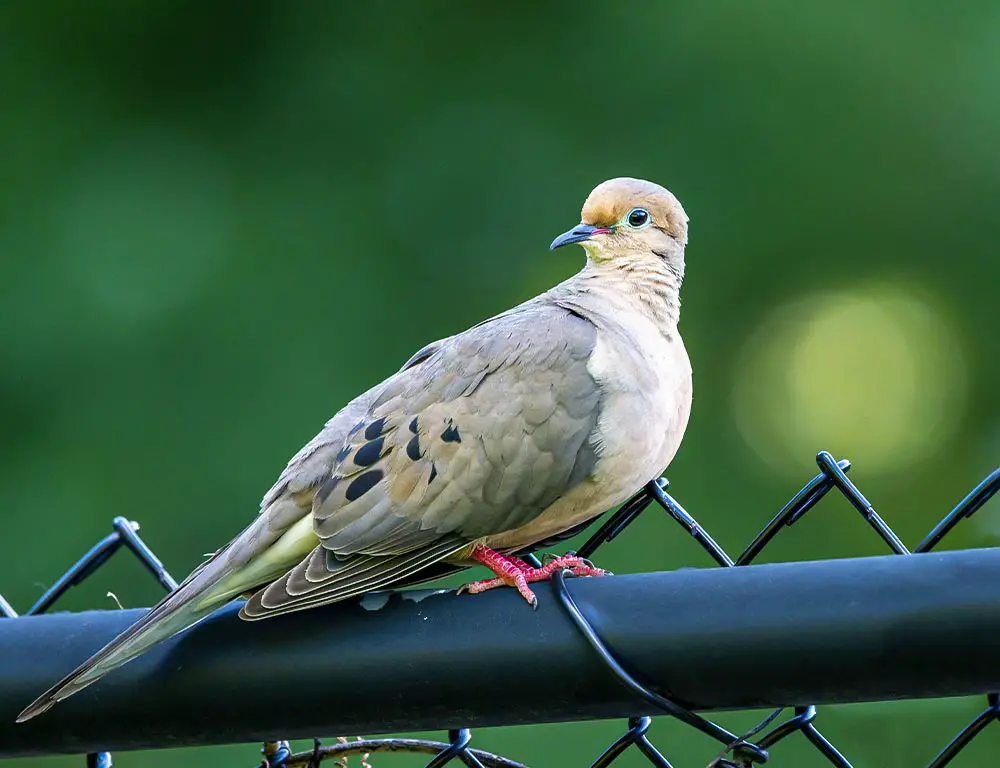
The Mourning Dove is a breathtakingly beautiful bird. It has stunning gray and brown feathers with white-tipped wings, giving it an elegant appearance. Its long tail also adds to its graceful look in flight.
A symbol of peace and serenity, they are abundant across North America and can be found in gardens or open fields throughout the year.
As well as being popular game birds for hunters, they feed on grains such as wheat and millet providing important food sources for wildlife species including foxes, coyotes, skunks, and raccoons.
These doves have a distinctive cooing sound that can often be heard echoing through woodlands during summer evenings making them one of nature’s greatest treasures.
Scientific classification:
| Kingdom | Animalia |
| Phylum | Chordata |
| Class | Aves |
| Order | Columbiformes |
| Family | Columbidae |
| Genus | Zenaida |
| Species | Z. macroura |
10. Black-Capped Chickadee

The black-capped chickadee is a small and cheerful songbird found in deciduous and mixed forests across North America. It has an iconic black cap, white cheeks, gray back, and wings with whitish bars on them.
The underparts are usually light-colored or greyish-brown. This species is well adapted to cold winters as it can reduce its body temperature by up to 8°C while roosting at night; this helps save energy during the colder months of the year.
It feeds mainly on insects but also eats seeds, fruits, and suet from bird feeders when available.
Black-capped chickadees are popular birds among backyard visitors due to their sociable nature – they often establish lifelong partnerships with one another for breeding purposes.
Furthermore, they have been designated as state birds of Massachusetts and Maine in the USA plus New Brunswick in Canada – a testament to how beloved these little avian friends truly are.
Scientific classification:
| Kingdom | Animalia |
| Phylum | Chordata |
| Class | Aves |
| Order | Passeriformes |
| Family | Paridae |
| Genus | Poecile |
| Species | P. atricapillus |
11. Red-Breasted Nuthatch

The Red-breasted Nuthatch is a beautiful and vocal songbird that can be found in coniferous forests across Canada, Alaska, the northeastern United States, and the western US.
This small bird has blue-grey upperparts with cinnamon underparts, a white throat and face with black eye stripe, a straight grey bill, and a black crown.
Its call sounds like a tin trumpet; it’s high-pitched yet nasal.
During mating season they form monogamous pairs to build their nest near tree trunks or branches at low heights off the ground where they lay 2 – 8 eggs at once.
They are very active little birds who love clinging to trees while searching for insect larvae or seeds within the bark of trees which helps control pest populations.
Scientific classification:
| Kingdom | Animalia |
| Phylum | Chordata |
| Class | Aves |
| Order | Passeriformes |
| Family | Sittidae |
| Genus | Sitta |
| Species | S. canadensis |
12. American Yellow Warbler
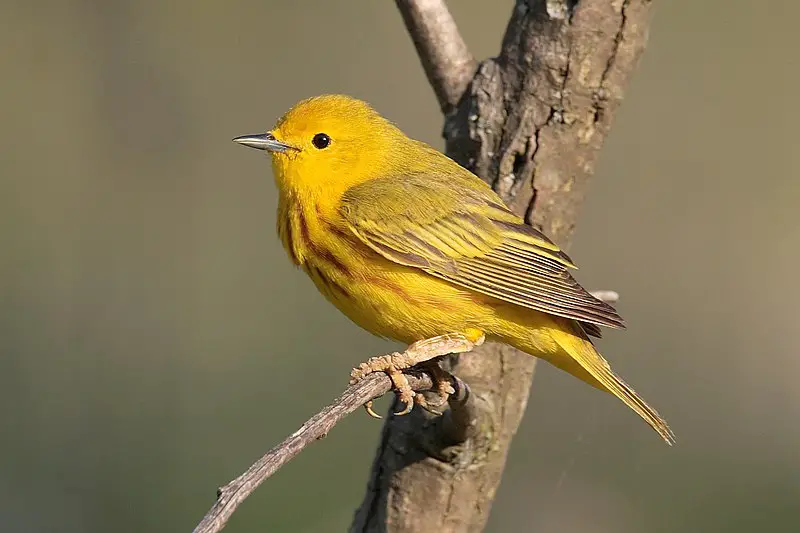
The American Yellow Warbler (Setophaga petechia) is a species of New World warbler found across North America, the Caribbean, and into northern South America.
Its genus name Setophaga comes from Ancient Greek words meaning “moth” and “eating”, while its specific name Petechia originates from Italian for small red spots.
This bird has striking yellow plumage with reddish-brown streaks on their chest that can be seen during mating season when they are most colorful.
They live in open woodlands near wetlands or bodies of water where they can find food such as insects like spiders, beetles, and caterpillars which make up much of their diet.
The male will sing to attract a mate during the breeding season before setting up a home in twig nests built by both sexes together high in trees or shrubs.
Scientific classification:
| Kingdom | Animalia |
| Phylum | Chordata |
| Class | Aves |
| Order | Passeriformes |
| Family | Parulidae |
| Genus | Setophaga |
| Species | S. petechia |
13. Brown-Headed Cowbird
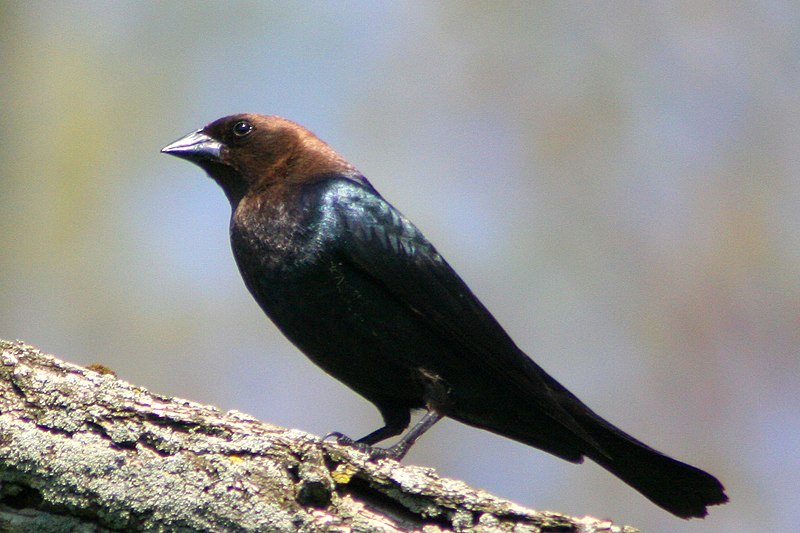
The Brown-headed Cowbird is a small, obligate brood parasitic icterid native to temperate and subtropical North America. It has a brown head with glossy black plumage on the body, wings, and tail feathers.
During summer months it can be found in prairies, grasslands as well as open wooded areas but during winter they migrate southwards towards the United States of Mexico for warmer climates.
They are mainly insectivorous birds that feed on insects like caterpillars or beetles but also consume some grains.
The female bird lays its eggs in nests of other species who then incubates them until hatching time thus leaving their chicks uncared for by themselves.
Scientific classification:
| Kingdom | Animalia |
| Phylum | Chordata |
| Class | Aves |
| Order | Passeriformes |
| Family | Icteridae |
| Genus | Molothrus |
| Species | M. ater |
14. Pine Siskin
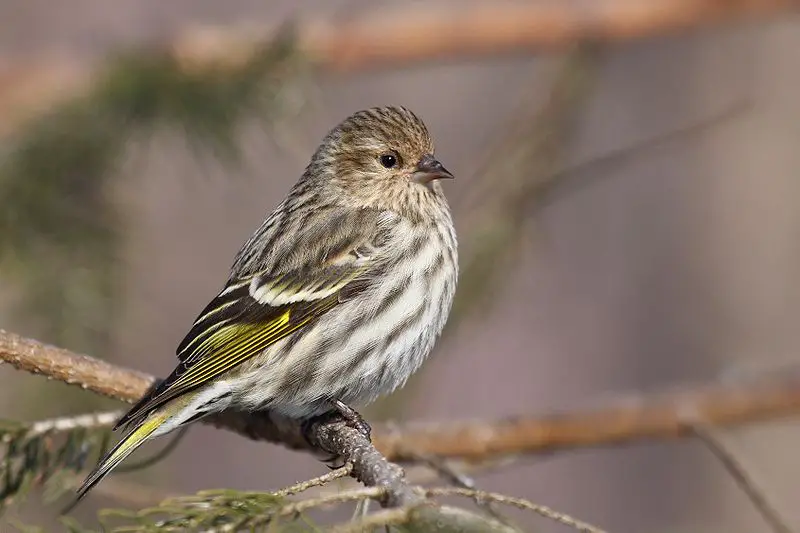
The Pine Siskin is a small bird from the finch family, primarily found in North America. It has an irregular migratory range and was first described by American ornithologist Alexander Wilson in 1810.
The species gets its name pinus, which means “pine-tree” in Latin, due to its frequent presence near coniferous trees.
Pine siskins are known for their yellow wing bars and streaked chests as well as their perky mannerisms when perched on branches or flying around looking for food during colder months.
They feed mostly on seeds of weeds, grasses, and other plants but can also be seen consuming insects at times during the summertime nesting season.
Its loud calls often alert nearby birds of potential danger while they nest high up among pine tree limbs where predators cannot reach them easily.
Scientific classification:
| Kingdom | Animalia |
| Phylum | Chordata |
| Class | Aves |
| Order | Passeriformes |
| Family | Fringillidae |
| Subfamily | Carduelinae |
| Genus | Spinus |
| Species | S. pinus |
15. Western Tanager
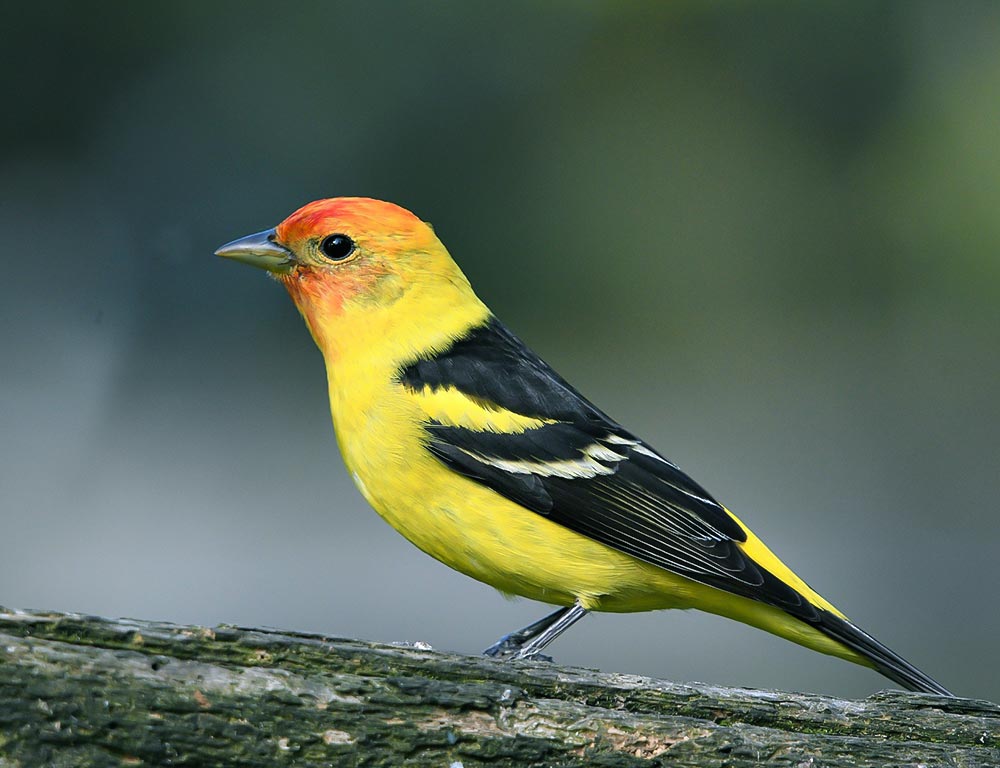
The Western Tanager (Piranga ludoviciana) is a medium-sized songbird belonging to the cardinal family, Cardinalidae. It was illustrated and formally described by American ornithologist Alexander Wilson in 1811.
The species has distinctive plumage including yellow feathers on its wings and tail, red shoulders, a black head with a white forehead patch, and grayish underparts.
Its vocalizations are also very similar to other members of the cardinal family – they have a high-pitched ‘tsee’ note followed by several sweeter notes that come together as parts of complex songs.
They primarily feed on fruit but will also take insects when available for extra protein during the breeding season.
These beautiful birds can be found throughout western North America from Alaska down through Mexico making them an iconic part of many landscapes.
Scientific classification:
| Kingdom | Animalia |
| Phylum | Chordata |
| Class | Aves |
| Order | Passeriformes |
| Family | Cardinalidae |
| Genus | Piranga |
| Species | P. ludoviciana |
16. Downy Woodpecker
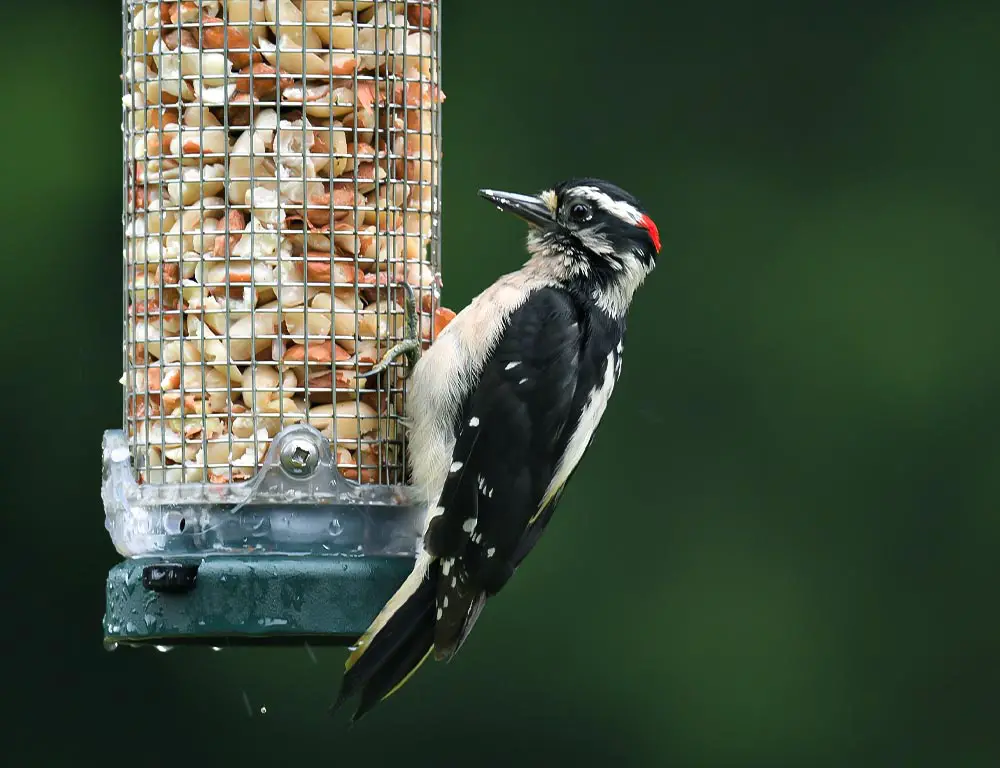
The downy woodpecker is a small species of woodpecker found in North America. Growing up to 7 inches long, it can be identified by its white belly and spotted wings.
It inhabits forests throughout the United States and Canada, except deserts in the southwest and northern tundra.
This bird nests in tree cavities and feeds mostly on insects but will supplement its diet with fruit or nuts when available.
The Downy Woodpecker has an unmistakable call that sounds like a loud ‘pik-er’, similar to other members of its family such as the Hairy Woodpecker.
Scientific classification:
| Kingdom | Animalia |
| Phylum | Chordata |
| Class | Aves |
| Order | Piciformes |
| Family | Picidae |
| Genus | Dryobates |
| Species | D. pubescens |
17. Dark-Eyed Junco

The Dark-eyed Junco is a species of small, grayish sparrows that are found across much of temperate North America and in the Arctic during summer.
It was formally described by Carl Linnaeus in 1766, who named it after its distinctive dark eyes.
This bird has a very variable appearance due to the many different subspecies it contains, making its systematics difficult to unravel.
The plumage varies from white or light gray on their underparts with slate grey backs and wings; black heads with white outer tail feathers; brown head stripes; yellow bills; pink legs and feet; as well as various shades between all these colours.
They also have considerable sexual dimorphism where males tend to be more colorful than females but share similar characteristics such as short tails and rounded bodies – both sexes being around 16 cm long when fully grown.
Scientific classification:
| Kingdom | Animalia |
| Phylum | Chordata |
| Class | Aves |
| Order | Passeriformes |
| Family | Passerellidae |
| Genus | Junco |
| Species | J. hyemalis |
18. Mountain Bluebird
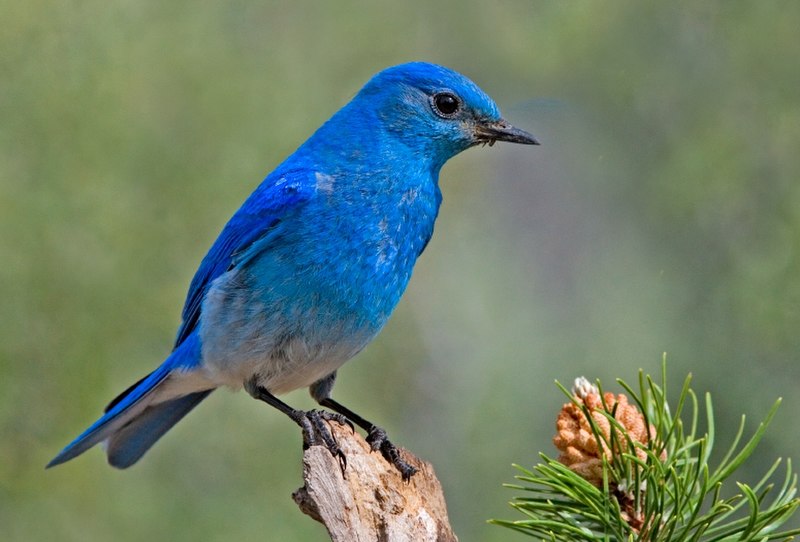
The Mountain Bluebird is a beautiful sight to behold. It has bright turquoise-blue wings and tail, with a light underbelly, grey crown, and breast, black eyes, and thin bills.
During the fall season, its plumage changes slightly – females have duller blue wings and tails, as well as a grey throat and back.
As they migrate across western North America during springtime these birds can be found in mountainous districts where they feed on insects such as grasshoppers or crickets collected from meadows or fields of grain.
They also enjoy eating berries when available. Through their stunning colors, this species adds vibrancy to any landscape it traverses through – truly an incredible creature of nature.
Scientific classification:
| Kingdom | Animalia |
| Phylum | Chordata |
| Class | Aves |
| Order | Passeriformes |
| Family | Turdidae |
| Genus | Sialia |
| Species | S. currucoides |
19. Eurasian Collared Dove
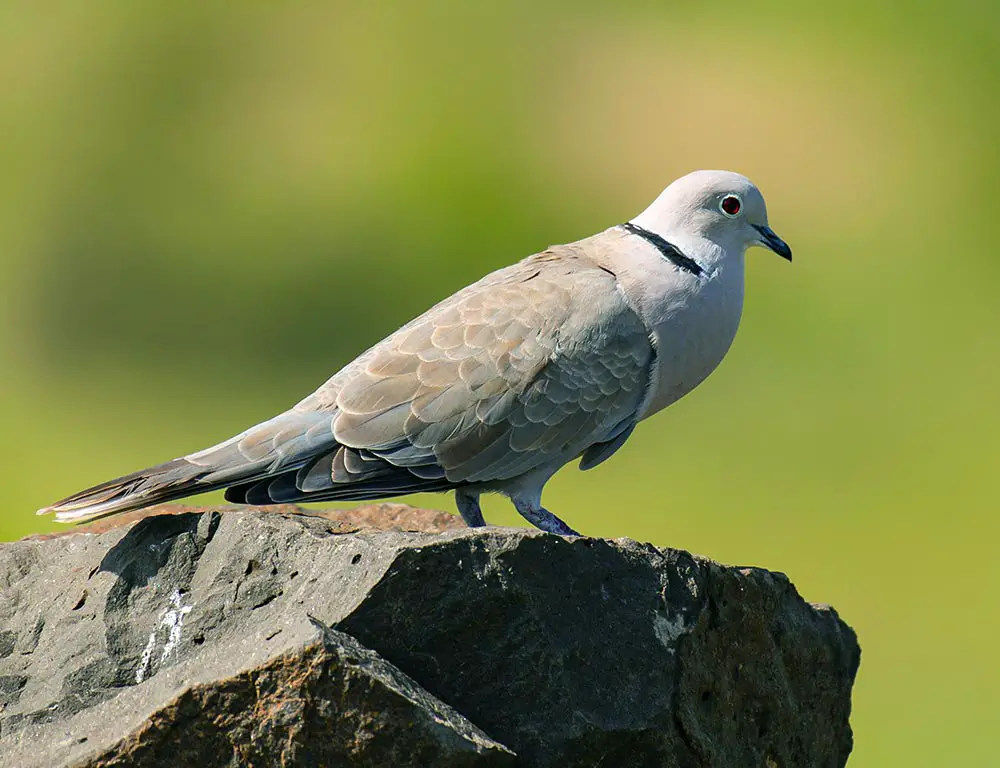
The Eurasian collared dove is a species of bird native to Europe and Asia, with its range expanding through introduction in Japan, North America, and islands in the Caribbean.
It has become so widespread that it is listed as Least Concern on the IUCN Red List. The scientific name for this bird was proposed by Hungarian naturalist Imre Frivaldsz – Columba decaocto.
This beautiful creature typically measures between 33-37 cm from tip to tail feathers, displaying an overall greyish brown plumage; they also have a distinctive black half collar around their neck which gives them their common name.
These birds are mainly found inhabiting open woodlands or agricultural lands near human settlements where there’s plenty of food available such as grain fields or gardens where fruits can be eaten off trees.
With a vast global population trend increasing steadily each year these birds make great additions to many backyards throughout the world.
Scientific classification:
| Kingdom | Animalia |
| Phylum | Chordata |
| Class | Aves |
| Order | Columbiformes |
| Family | Columbidae |
| Genus | Streptopelia |
| Species | S. decaocto |
20. White-Crowned Sparrow
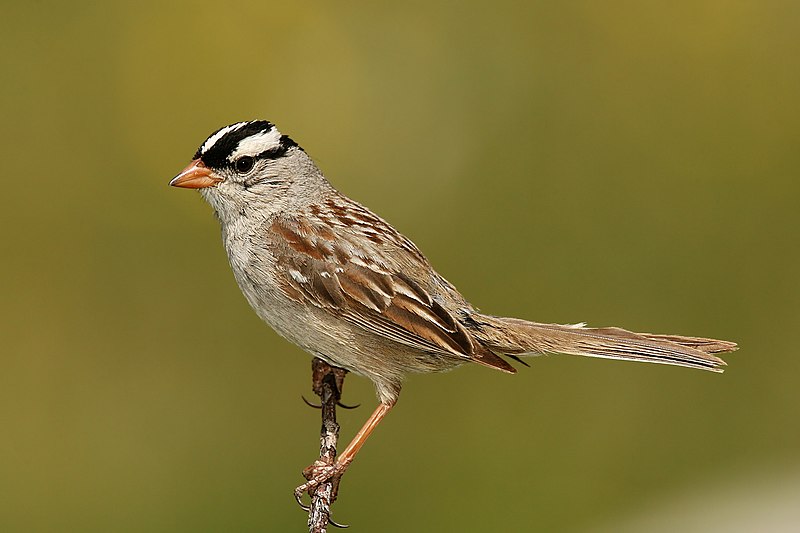
The White-crowned Sparrow is a species of passerine bird native to North America. It has a grey face and black and white streaking on its upper head, making it easy to identify.
This sparrow usually breeds in brushy areas located in the taiga, tundra, Rocky Mountains, or Pacific coast regions of North America.
During winter months these birds migrate southward as far as Mexico and California where they can be found living amongst chaparral shrubbery or low bushes near open fields with plenty of seeds nearby.
The diet of this bird consists mainly of insects during summer while they switch over to eating grains like wheat & oats during colder months when bugs are scarce.
They are known for their characteristic chirp which sounds like “Oh sweet Canada Canada” drawing admirers from around the world.
Scientific classification:
| Kingdom | Animalia |
| Phylum | Chordata |
| Class | Aves |
| Order | Passeriformes |
| Family | Passerellidae |
| Genus | Zonotrichia |
| Species | Z. leucophrys |
21. Brewer’s Blackbird
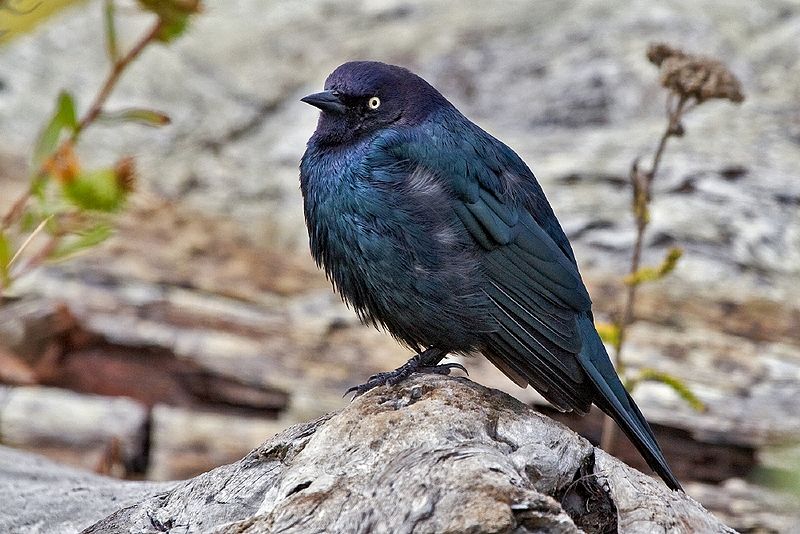
Brewer’s blackbird is a medium-sized New World bird that can be easily identified by its glossy, iridescent purple head and neck.
The body of the male has bluish-green highlights while females have brownish-grey plumage with slight hints of the male’s iridescence.
Both sexes possess bright yellow eyes, black feet and legs, and dark wings. Brewer’s blackbirds are commonly found in open grasslands or shrubland habitats.
They prefer to eat insects but will also feed on grains such as wheat or corn if available during winter months when insect populations decline.
These birds often form large flocks which protect them from predators like hawks or owls looking for an easy meal.
Scientific classification:
| Kingdom | Animalia |
| Phylum | Chordata |
| Class | Aves |
| Order | Passeriformes |
| Family | Icteridae |
| Genus | Euphagus |
| Species | E. cyanocephalus |
Also Featured In: Birds Commonly Found in Northern California, Birds that Live in San Francisco Bay Area
22. Bullock’s Oriole
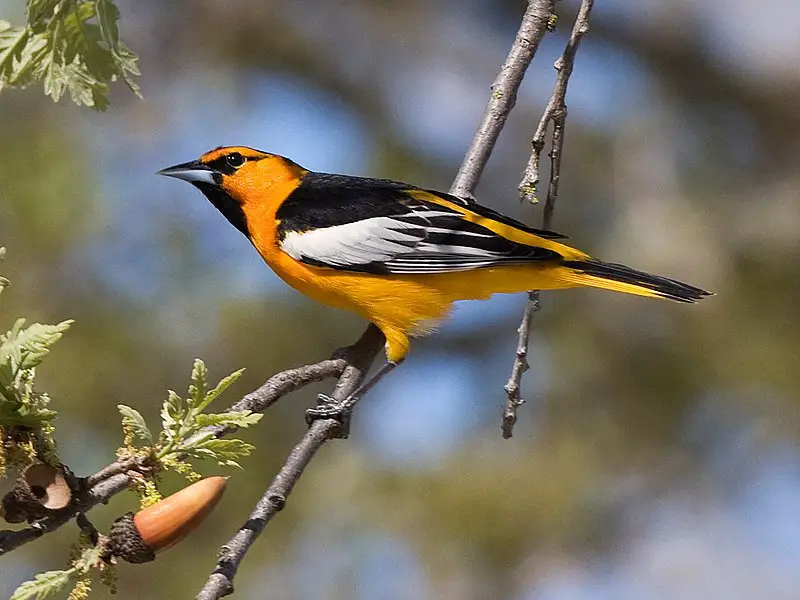
Bullock’s oriole is a small, sexually dimorphic New World blackbird that was once thought to be the same species as the Baltimore Oriole. It was named after William Bullock, an English amateur naturalist.
Male birds are more brightly colored and slightly larger than females. These birds typically have yellow heads and wings with dark brown or black bodies with white bars on their backs and tails.
They can often be seen perched high up in trees foraging for insects among foliage or singing from branches during mating season.
Their diet consists of mostly fruits such as oranges, apples, and plums; they also eat some seeds like millet along with grasshoppers and other insects when available.
The Bullock’s oriole is found throughout western North America in areas of woodland scrubland which shelter it from predators while providing plenty of food sources to sustain itself year round.
Scientific classification:
| Kingdom | Animalia |
| Phylum | Chordata |
| Class | Aves |
| Order | Passeriformes |
| Family | Icteridae |
| Genus | Icterus |
| Species | I. bullockii |
23. Red Crossbill
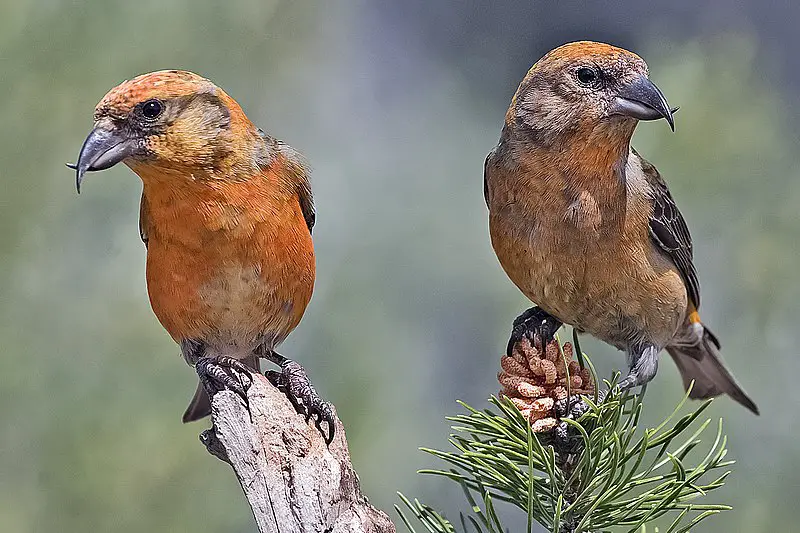
The Red Crossbill is a small passerine bird belonging to the finch family. It has distinctively crossed mandibles, which it uses to extract seeds from conifer cones and other fruits.
This species can be identified by its vivid colouring; males are red or orange in hue whilst females tend to have more green or yellow feathers.
Furthermore, there is considerable variation between individuals of this species when it comes to their beak’s size and shape as well as their calls—which range from short trills through chirps and harsh cackles up to loud rattling sounds at times.
They’re an interesting sight in many parts of Europe, particularly during winter months where they often feed on pine cone seeds that drop down onto lower branches of trees.
Scientific classification:
| Kingdom | Animalia |
| Phylum | Chordata |
| Class | Aves |
| Order | Passeriformes |
| Family | Fringillidae |
| Subfamily | Carduelinae |
| Genus | Loxia |
| Species | L. curvirostra |
24. Western Meadowlark
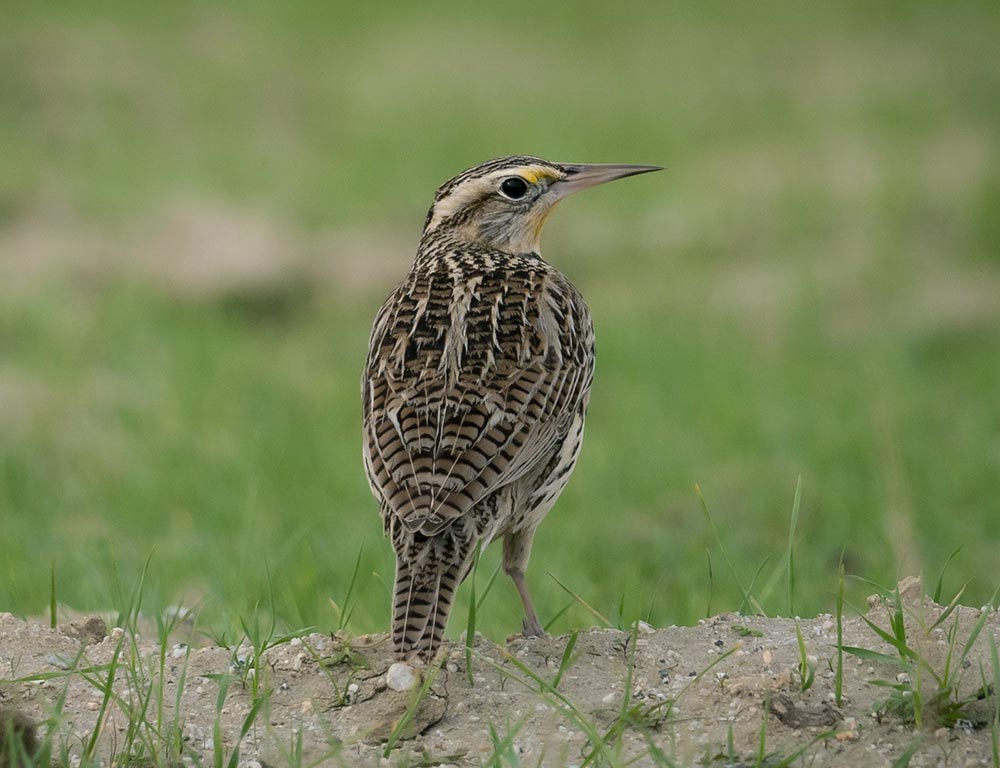
The western meadowlark is a medium-sized icterid bird native to North America. It has a distinct yellow breast with black and white patches, making it easy to spot in open grasslands.
Its diet consists of mostly bugs but also includes seeds and berries. The western meadowlark’s call is unique – its sound is described as flute-like or watery, differentiating it from the similar eastern meadowlark species.
When the nesting season arrives, they build their nests on the ground near shrubs or low trees in areas like fields and pastures.
This beautiful songbird adds life to our open lands with its melodious tunes.
Scientific classification:
| Kingdom | Animalia |
| Phylum | Chordata |
| Class | Aves |
| Order | Passeriformes |
| Family | Icteridae |
| Genus | Sturnella |
| Species | S. neglecta |
25. Yellow-Rumped Warbler

The Yellow-rumped Warbler (Setophaga coronata) is a migratory bird species that can be found throughout North America.
It has an extensive range, from the Pacific and Atlantic coasts of the US to Canada and Central America, with a concentration in northern areas during the breeding season.
These birds migrate southwards for wintering grounds where they find plentiful food sources such as insects and berries.
They are easily identified by their yellow patches on either side of their tails, along with white underparts, gray back feathers, and two distinct crown stripes.
One black or greyish-brown above the eyes extends towards its neck banded in yellow or light brown coloration.
Furthermore, these warblers have strong legs which allow them to cling onto branches while hunting for prey making them adept at maneuvering through tree cover quickly.
Altogether this makes the Yellow-rumped Warbler an attractive backyard visitor year-round.
Scientific classification:
| Kingdom | Animalia |
| Phylum | Chordata |
| Class | Aves |
| Order | Passeriformes |
| Family | Parulidae |
| Genus | Setophaga |
| Species | S. coronata |
26. Accipitridae
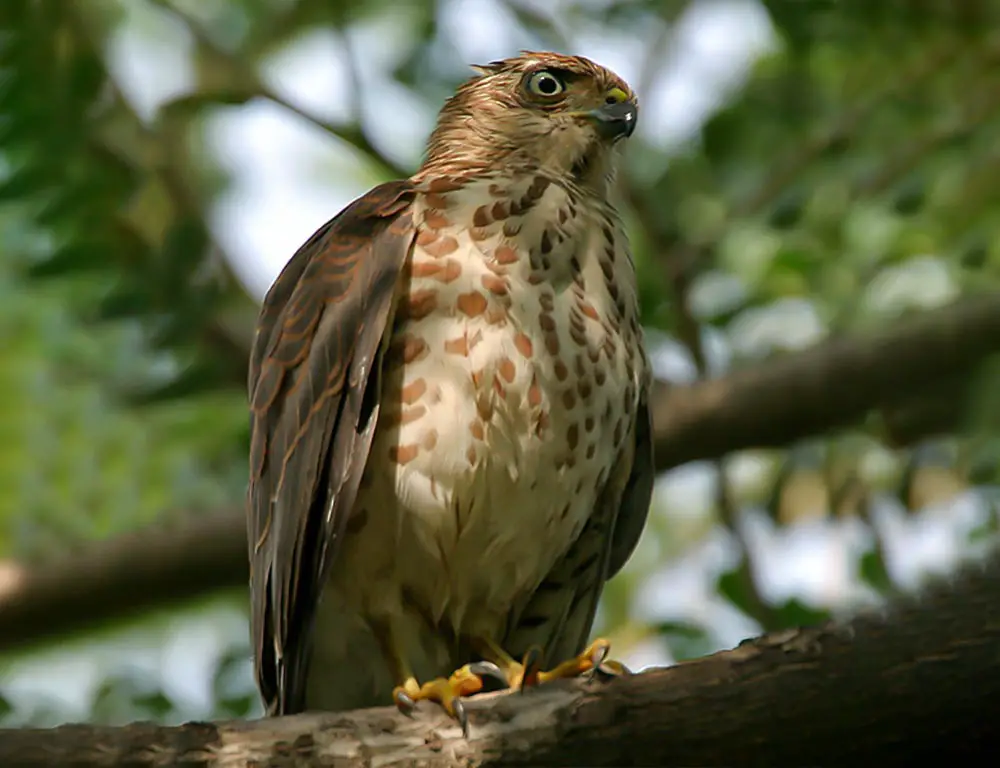
Accipitridae birds are a diverse family of raptors ranging in size from small to large. They have powerful hooked beaks which they use for hunting and tearing apart their prey, such as insects, medium-sized mammals, and carrion.
Some species even feed on fruit. These birds can be found all over the world, making them an incredibly successful group of predators.
Accipitridae are adaptable hunters with keen eyesight that helps them spot potential meals from far away distances.
Their sharp talons assist them in grasping onto their victims while feeding or defending themselves against enemies.
Not only do these avian creatures provide us with visual beauty but also help keep our ecosystems healthy by keeping pest populations under control.
Scientific classification:
| Kingdom | Animalia |
| Phylum | Chordata |
| Class | Aves |
| Order | Accipitriformes |
| Family | Accipitridae Vieillot, 1816 |
27. American Avocet
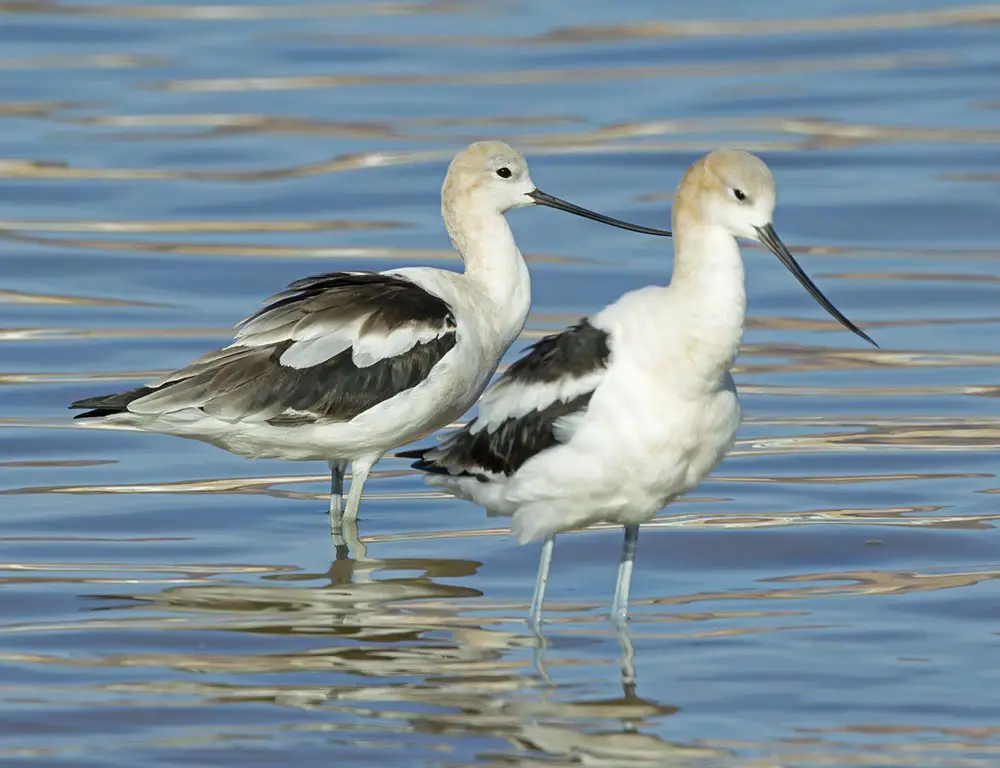
The American Avocet is a stunningly beautiful bird found in North America. With its striking black and white plumage, long blue legs, and upturned bill it is an unmistakable sight.
It spends much of its time foraging around shallow water or mud flats searching for crustaceans and insects to feed on by sweeping its beak from side to side through the water.
The German naturalist Johann Friedr formally described this species back in 1789 as Recurvirostra americana – aptly named due to their habit of recurving their bills when feeding.
These graceful wading birds are truly a marvel of nature that deserves our admiration.
Scientific classification:
| Kingdom | Animalia |
| Phylum | Chordata |
| Class | Aves |
| Order | Charadriiformes |
| Family | Recurvirostridae |
| Genus | Recurvirostra |
| Species | R. americana |
28. Red-Tailed Hawk
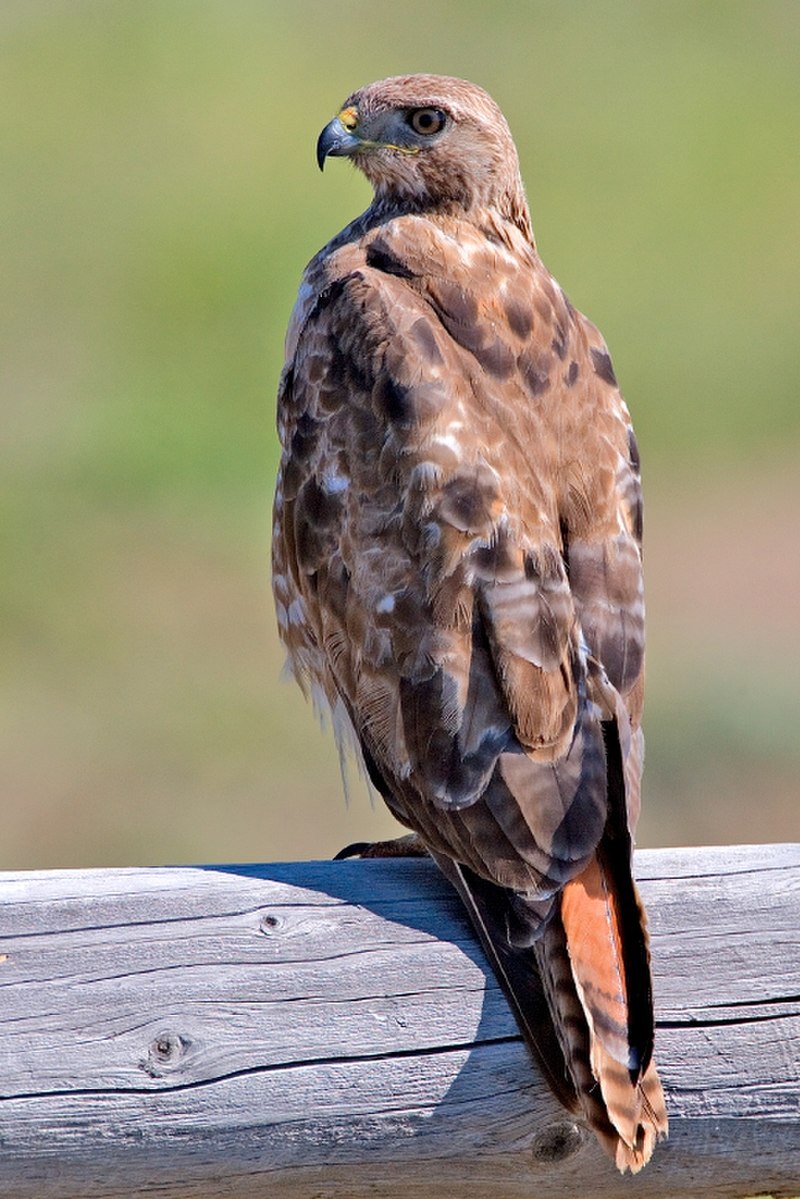
The Red-tailed Hawk is a majestic bird of prey with a distinctive red tail. It can be found throughout North America, from Alaska in the north to Panama and the West Indies in the south.
This species belongs to the Buteo genus, which makes it one of the most common raptors on Earth.
These hawks mainly hunt small mammals such as rabbits or squirrels but also feed on reptiles and birds during migration season.
Unlike other predator birds, they prefer open areas for hunting like fields or grasslands rather than dense forests.
They build their nests high up on trees where they stay all year long unless disturbed by humans or animals nearby.
Their presence has become an iconic part of American culture due to their frequent sightings around homes and parks alike making them beloved creatures among people everywhere.
Scientific classification:
| Kingdom | Animalia |
| Phylum | Chordata |
| Class | Aves |
| Order | Accipitriformes |
| Family | Accipitridae |
| Genus | Buteo |
| Species | B. jamaicensis |
29. Lazuli Bunting
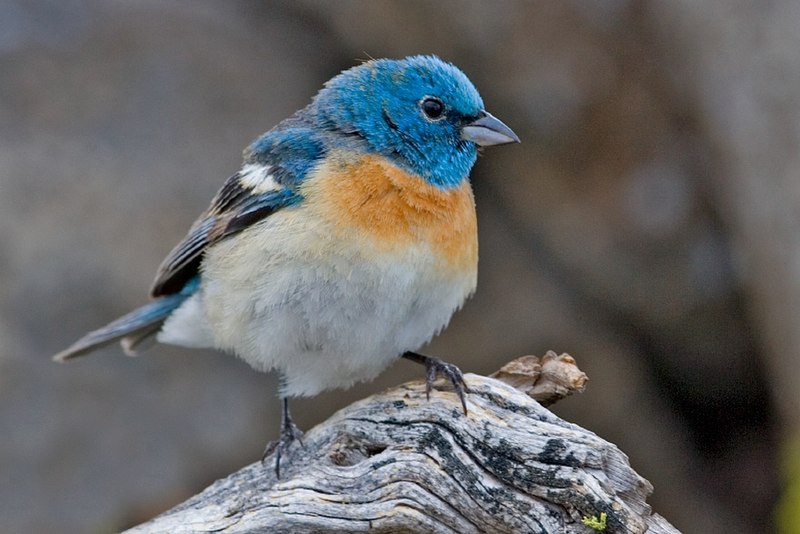
The Lazuli Bunting is a beautiful North American songbird, aptly named for its bright blue head and back that resemble the gemstone lapis lazuli.
With white wing bars contrasting against its light rusty breast and white belly, it stands out from other birds.
Measuring only 11-13 centimeters in length, this small bird holds an unmistakable beauty with distinct coloring which sets it apart from eastern or western bluebirds of similar size.
The male’s brilliant hues have made them popular among birdwatchers throughout the United States as they migrate along their yearly route each spring and summer to breed before returning southward again come fall.
Scientific classification:
| Kingdom | Animalia |
| Phylum | Chordata |
| Class | Aves |
| Order | Passeriformes |
| Family | Cardinalidae |
| Genus | Passerina |
| Species | P. amoena |
Also Featured In: Blue Birds You’ll Found around Us, Blue Birds that You’ll Find in Utah
30. Chipping Sparrow
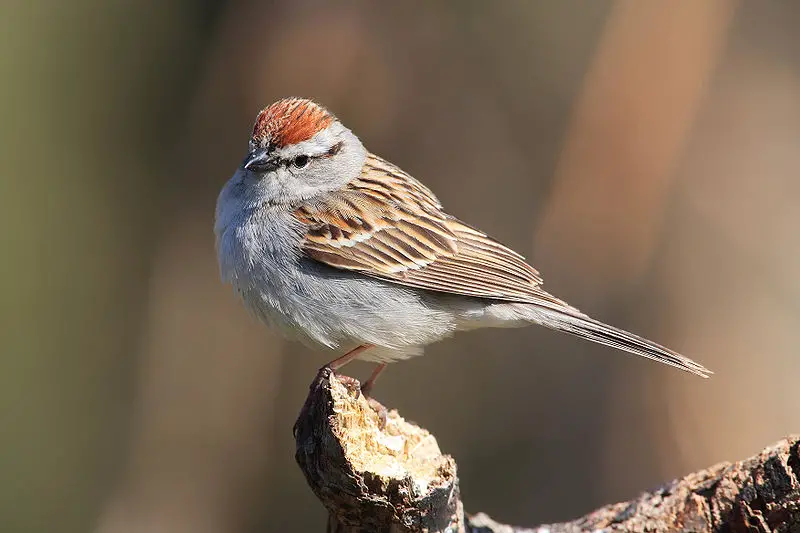
The Chipping Sparrow is a small passerine bird found across most of North America. It has two subspecies, the eastern and western chipping sparrows which migrate seasonally to overwinter in warmer climates.
The birds are grey above with white underparts, have a rufous cap with black stripes, and large eyes surrounded by light brown feathers.
They feed mainly on seeds but can also be seen eating insects during breeding season when raising their young chicks.
These intrepid little birds live in open grasslands such as prairies or meadows where they build cup-shaped nests in trees or shrubs to raise their young family.
Their cheerful song often sounds like ‘chips’ hence its name; Chipping Sparrow.
Scientific classification:
| Kingdom | Animalia |
| Phylum | Chordata |
| Class | Aves |
| Order | Passeriformes |
| Family | Passerellidae |
| Genus | Spizella |
| Species | S. passerina |
31. Wilson’s Warbler
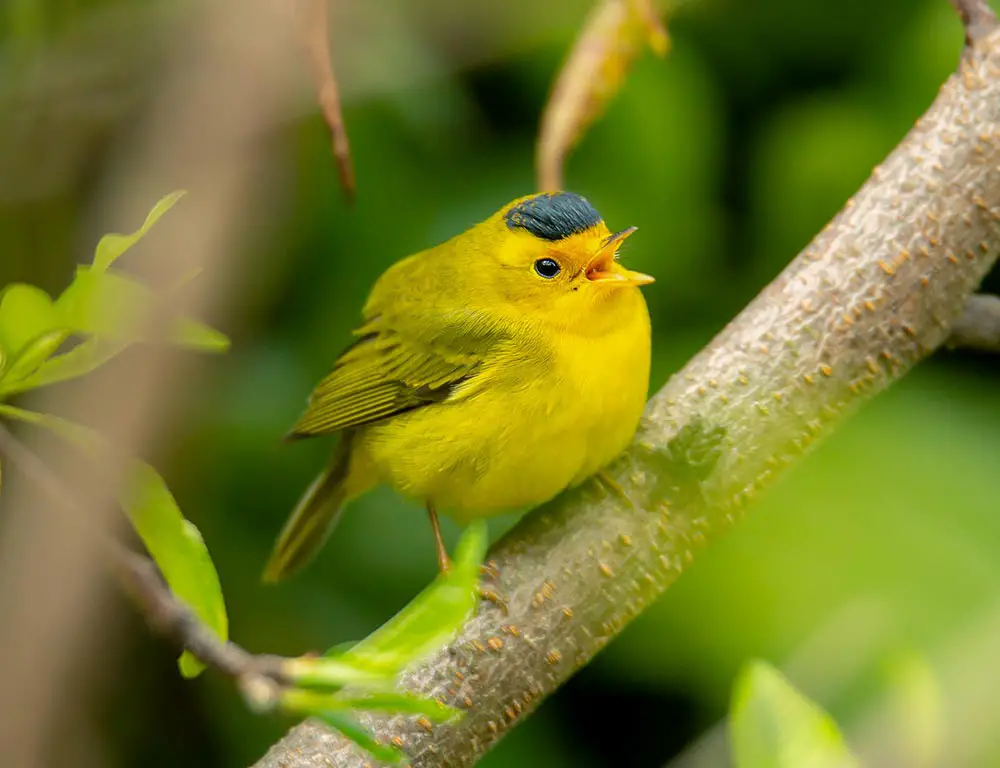
Wilson’s warbler is a small, brightly colored bird found across North America. It has greenish upperparts and yellow underparts, with rounded wings and a long tail.
The male has an easily identifiable black crown patch which may or may not be present in the female depending on the subspecies.
They breed from Canada down to central parts of Mexico and then winter south through much of Central America.
These birds are usually seen flitting around low vegetation as they search for insects to eat – their main food source.
Their cheerful song can often be heard during spring migration when they travel back up north to breed again after spending winter further south.
Scientific classification:
| Kingdom | Animalia |
| Phylum | Chordata |
| Class | Aves |
| Order | Passeriformes |
| Family | Parulidae |
| Genus | Cardellina |
| Species | C. pusilla |
32. Cooper’s Hawk
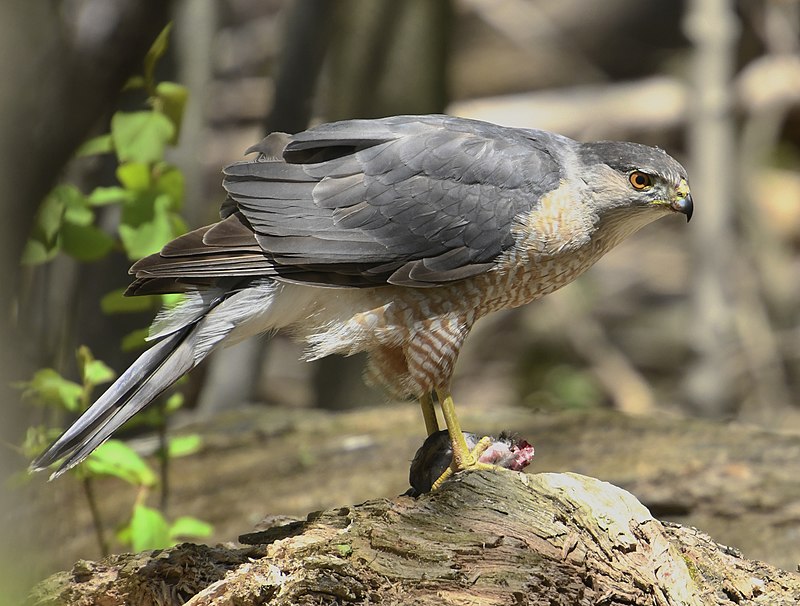
Cooper’s Hawk is a medium-sized bird of prey native to North America. It belongs to the Accipiter genus, which is known for its agility and small size compared to other hawks.
They usually inhabit wooded areas, making them well-adapted hunters in dense environments.
Cooper’s Hawks have rounded wings with short tails that help them maneuver quickly through trees when chasing after prey such as small rodents or birds.
These raptors also possess powerful feet equipped with sharp talons used for catching food items on the ground and even out of midair.
The adult plumage has barred upperparts, ranging from greyish brown on lighter individuals up to dark chestnut colors found in darker specimens; they also display rusty underparts marked by thin white streaking down either side of their chests and bellies.
Scientific classification:
| Kingdom | Animalia |
| Phylum | Chordata |
| Class | Aves |
| Order | Accipitriformes |
| Family | Accipitridae |
| Genus | Accipiter |
| Species | A. cooperii |
33. Mountain Chickadee
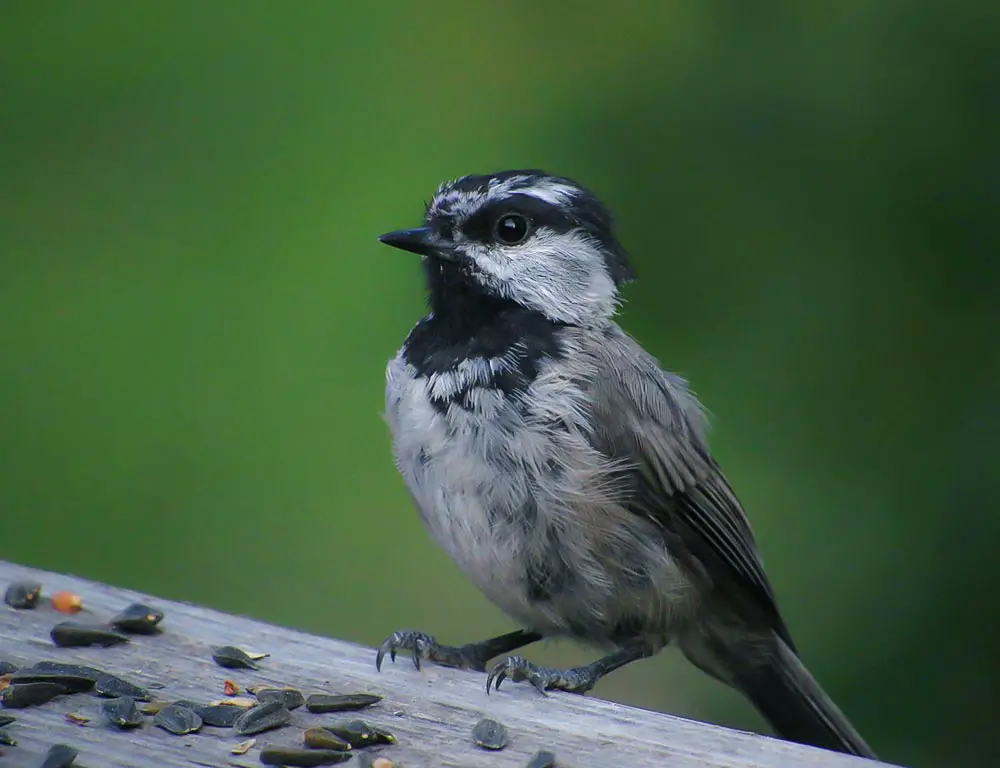
The Mountain Chickadee is a small songbird in the tit family Paridae. Its distinct features include its black cap and bib, white cheeks, gray back, and buffy underparts.
This bird was named after an American naturalist called William Gambel.
Recent studies have suggested that this species should be separated from other tits due to differences in their mitochondrial DNA cytochrome B sequence data as well as physical characteristics such as morphology.
They inhabit coniferous forests of North America between Alaska’s Aleutian Islands down to northern Mexico.
The diet of these birds consists mainly of insects but they are also known to eat seeds and berries at times.
These active little birds often join mixed-species foraging flocks during wintertime with other chickadees, nuthatches, or kinglets which helps them survive colder climates by pooling resources together when food sources become sparse.
Scientific classification:
| Kingdom | Animalia |
| Phylum | Chordata |
| Class | Aves |
| Order | Passeriformes |
| Family | Paridae |
| Genus | Poecile |
| Species | P. gambeli |
34. Varied Thrush
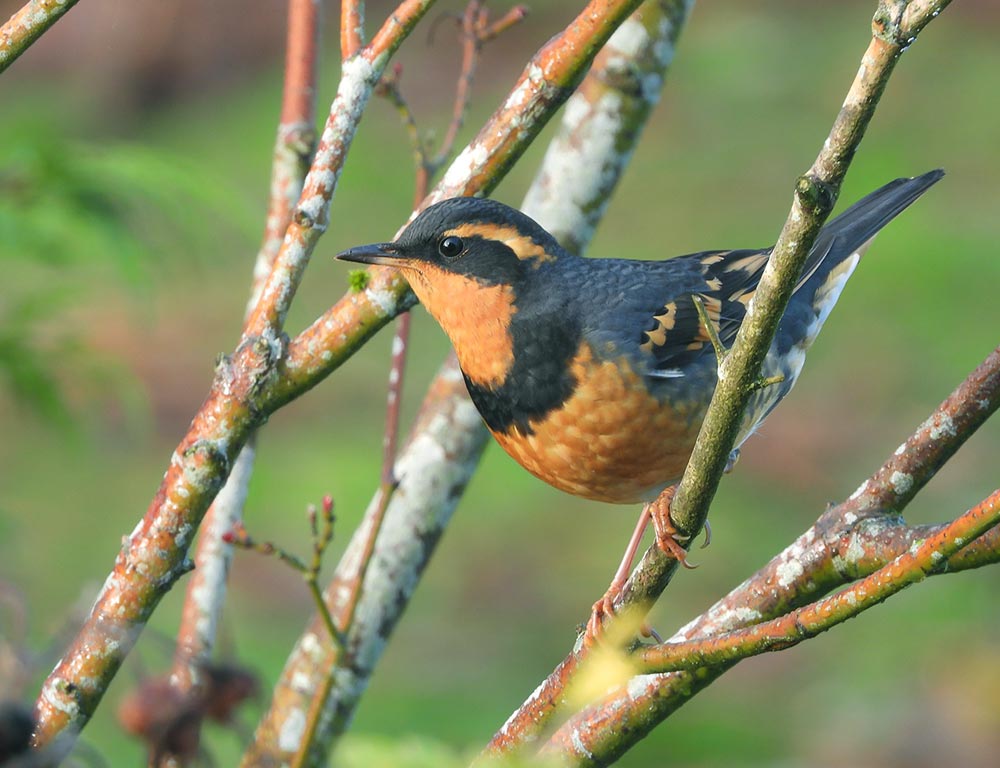
The Varied Thrush (Ixoreus naevius) is the only species in its genus and belongs to the thrush family, Turdidae.
It was first described by German naturalist Johann Friedrich Gmelin in 1789 as Turdus naevius, based on a specimen owned by John Latham which had been described as “Spotted Thrush” four years earlier.
This bird has an olive-brown back with reddish streaks along white underparts; it also bears spots of yellow or orange coloring across its chest.
Its wings are black with bold white patches while its tail appears long and pointed at times when spread out during flight.
The varied thrush can be found throughout western North America from Alaska southwards into California, Arizona, New Mexico, and northern Mexico where they prefer habitats such as coniferous forests and mountain areas near streams or rivers for their habitat.
They feed mainly on insects but will also eat fruits if available making them omnivorous birds.
Scientific classification:
| Kingdom | Animalia |
| Phylum | Chordata |
| Class | Aves |
| Order | Passeriformes |
| Family | Turdidae |
| Genus | Ixoreus Bonaparte, 1854 |
| Species | I. naevius |
35. Ruby-Throated Hummingbird

The ruby-throated hummingbird (Archilochus colubris) is a species of hummingbird that has an impressive migration pattern, spending the winter in Central America, Mexico, and Florida before flying to Canada and other parts of Eastern North America for the breeding season.
It’s by far the most common type seen east of the Mississippi River in North America.
Formally described by Swedish naturalist Carl Linnaeus in 1758, this tiny bird has bright metallic green upperparts with white underparts, a small black bill, and a red throat patch which gives it its name; they measure around 3 inches long on average.
They feed primarily on nectar from flowers but also eat insects such as flies or mosquitoes for extra protein during their migrations or when raising young chicks.
Scientific classification:
| Kingdom | Animalia |
| Phylum | Chordata |
| Class | Aves |
| Order | Apodiformes |
| Family | Trochilidae |
| Genus | Archilochus |
| Species | A. colubris |
36. Sharp-Shinned Hawk
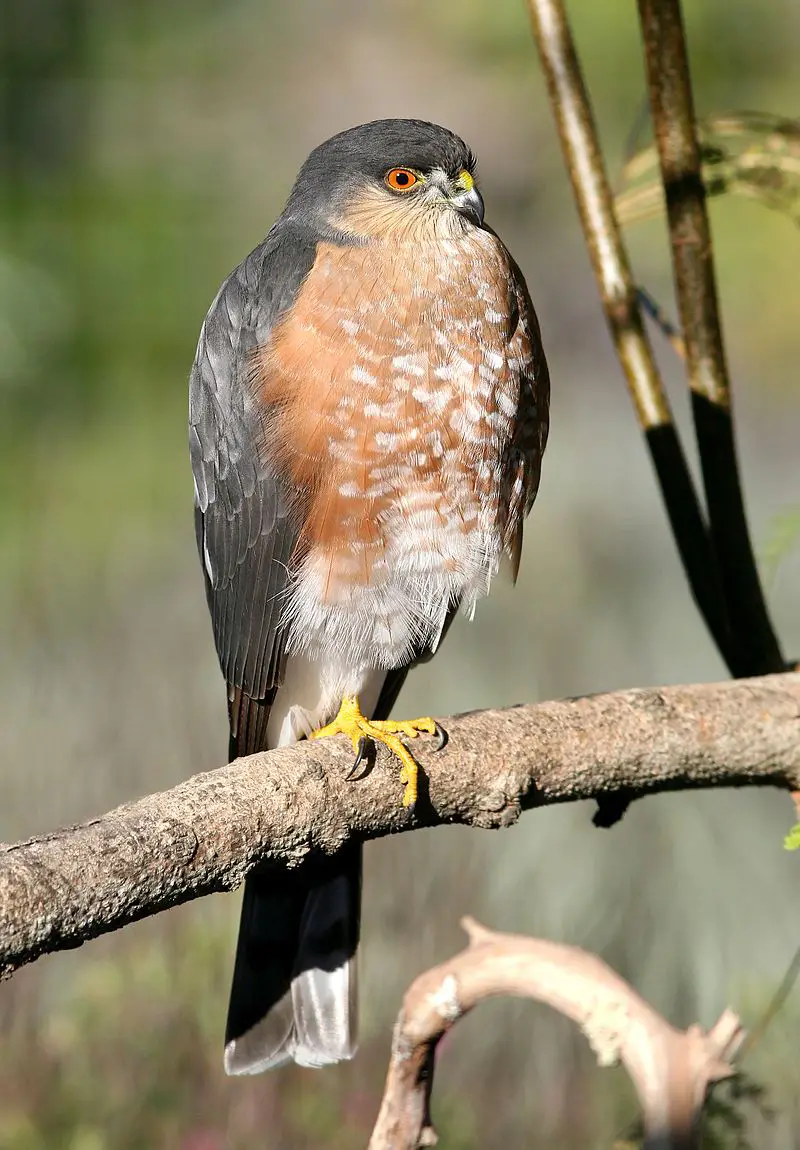
The Sharp-shinned Hawk is a small hawk found throughout the United States and Canada. It is one of the smallest hawks in North America, but larger than some Neotropical species such as the tiny hawk.
The taxonomy of this bird remains uncertain; with some authorities suggesting that southern taxa may represent three distinct species: white-breasted hawk (A. chionogaster), plain-breasted hawk (A. ventralis) and rufous morph sharp-shinnedhawk(A. rufiventris).
These birds feed primarily on small birds like finches, sparrows, woodpeckers, and warblers while hunting from perches or by flying through dense vegetation to surprise unsuspecting prey items.
They are agile flyers that rely heavily on surprise to capture their food items quickly before they can fly away.
Scientific classification:
| Kingdom | Animalia |
| Phylum | Chordata |
| Class | Aves |
| Order | Accipitriformes |
| Family | Accipitridae |
| Genus | Accipiter |
| Species | A. striatus |
37. Loons
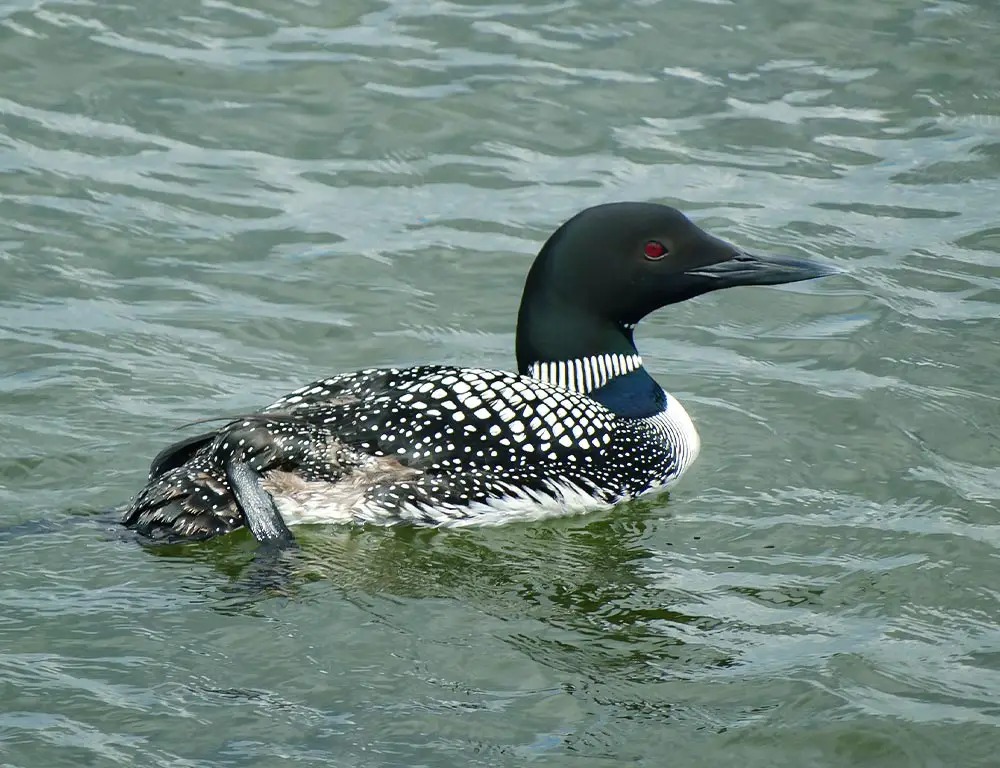
Loons are aquatic birds found in both North America and northern Eurasia. They can be identified by their size, which is similar to that of large ducks or small geese.
When swimming, loons resemble these birds in shape as well as movement.
Unlike other waterfowl however, they have pointed bills with serrated edges and feet set far back on their bodies; this makes them excellent swimmers but hinders the ability to walk on land properly.
Loons feed mainly on fish but also eat insects and crustaceans when available.
In addition to being a common sight around lakes during warmer months, many species migrate south for winter where they live near coastal waters until returning in springtime.
Scientific classification:
| Kingdom | Animalia |
| Phylum | Chordata |
| Class | Aves |
| Order | Gaviiformes |
| Family | Gaviidae Coues, 1903[1] |
| Genus | Gavia Forster, 1788 |
38. Snow Bunting
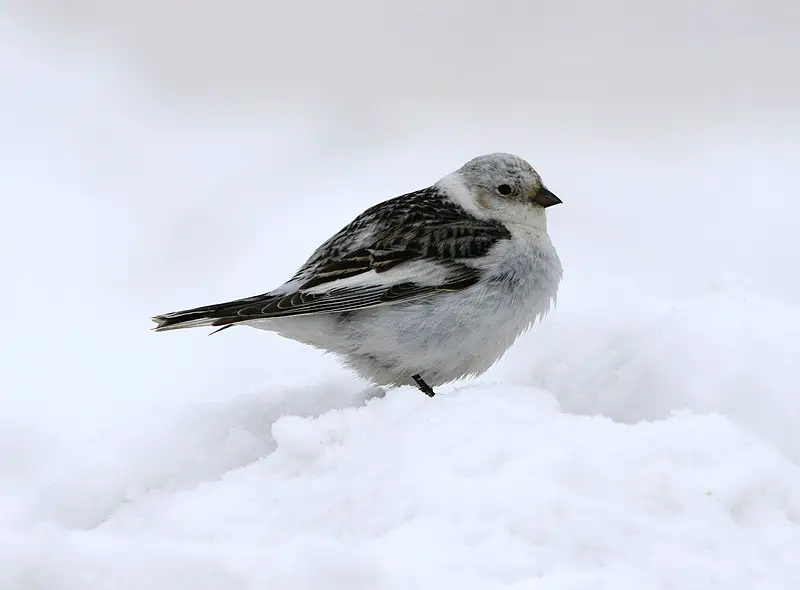
The snow bunting is a small and colorful passerine bird found in the Arctic regions of the northern hemisphere.
With its bright white feathers and black markings on its wings and tail, it stands out amongst other birds that inhabit these cold climates.
This species has adapted well to surviving in this harsh environment; they nest under boulders or rocks so their eggs are shielded from predators and blizzards alike.
They feed mainly on insects during summer months but switch to seeds when winter arrives as they seek food sources that will not freeze over with ice.
The Snow bunting is an important part of the local ecosystem due to providing sustenance for larger animals such as foxes and owls who rely upon them for survival throughout wintertime.
Scientific classification:
| Kingdom | Animalia |
| Phylum | Chordata |
| Class | Aves |
| Order | Passeriformes |
| Family | Calcariidae |
| Genus | Plectrophenax |
| Species | P. nivalis |
39. Evening Grosbeak
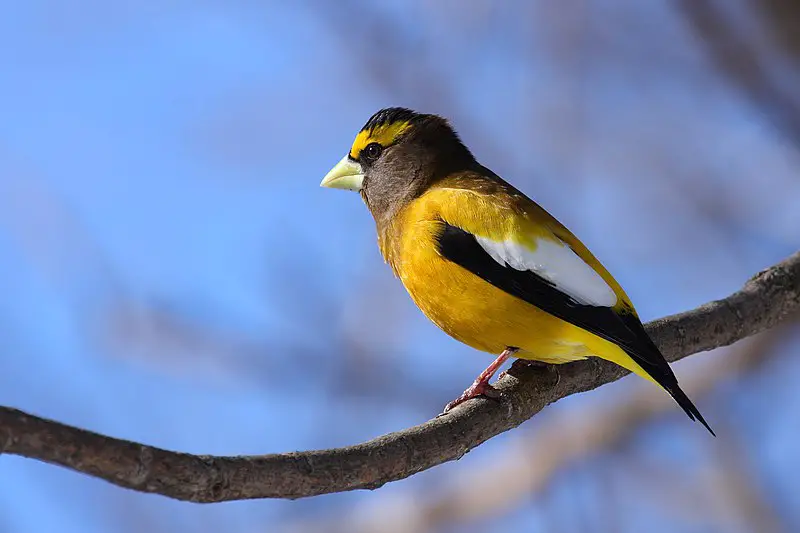
The Evening Grosbeak (Hesperiphona vespertina) is a beautiful passerine bird in the finch family Fringillidae native to North America.
It has an impressive wingspan of up to 20 inches and its plumage is mostly black, yellow, or grey with distinctive white patches on each side of its head.
Its diet consists mainly of seeds and other plant matter as well as small insects, fruit, and berries when available.
The male’s song is loud and melodic which can be heard from some distance away during breeding season making it a popular species for avid backyard birders.
The Evening Grosbeak typically nests high in coniferous trees where they build cup-shaped structures lined with feathers or grass that protect predators.
Overall this species makes an excellent addition to any backyard aviary.
Scientific classification:
| Kingdom | Animalia |
| Phylum | Chordata |
| Class | Aves |
| Order | Passeriformes |
| Family | Fringillidae |
| Subfamily | Carduelinae |
| Genus | Hesperiphona |
| Species | H. vespertina |
40. Cassin’s Finch
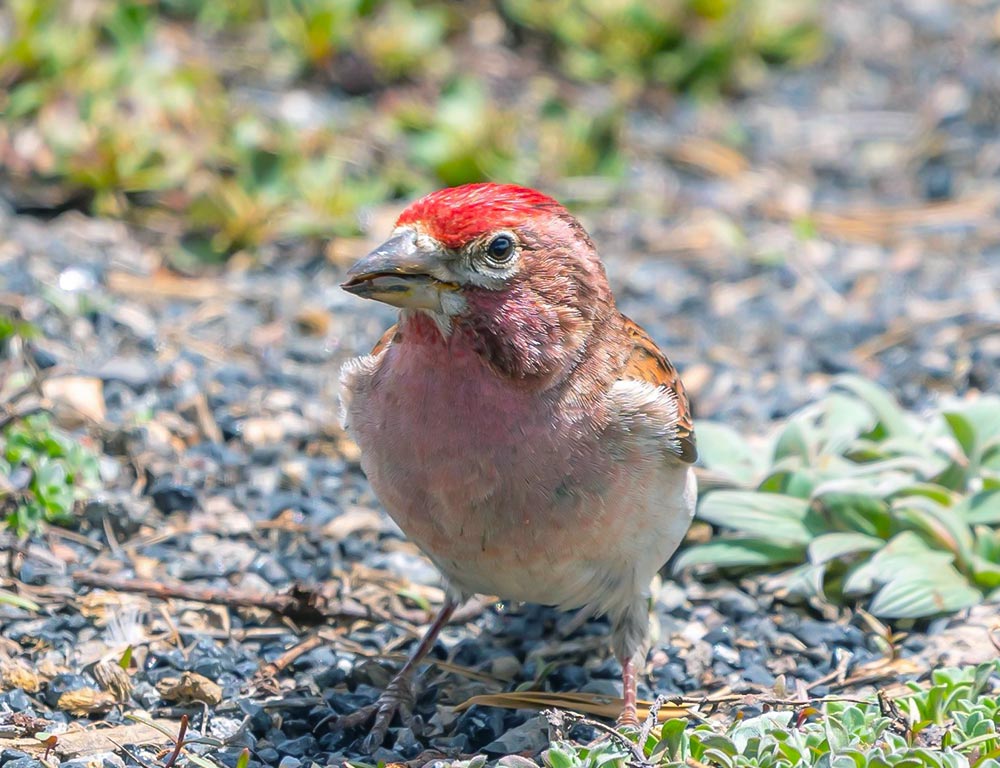
Cassin’s finch is a species of bird belonging to the Fringillidae family. It has brown wings and a tail, with a longer bill than that of the purple finch.
Adult males are raspberry red on their head, breast, back, and rump with streaked backs and undertail feathers.
The adult female Cassin’s Finch is duller in coloration than the male but still shows pinkish tones around its face and neck area as well as subtle streaks across its body.
This species can be found mainly in western North America from Alaska down to California where they inhabit coniferous forests along mountain slopes or near riversides at elevations between 500-3000 meters above sea level.
They feed mainly on grasshoppers, caterpillars, and other insects which they pick up while foraging through vegetation or by flying out onto open ground surfaces.
Scientific classification:
| Kingdom | Animalia |
| Phylum | Chordata |
| Class | Aves |
| Order | Passeriformes |
| Family | Fringillidae |
| Subfamily | Carduelinae |
| Genus | Haemorhous |
| Species | H. cassinii |
41. Northern Goshawk

The Northern Goshawk is a medium-large bird of prey belonging to the Accipitridae family. It has been known as one of the true hawks, with “Accipiter” meaning hawk in Latin and “gentilis” referring to its noble characteristics.
They are found worldwide, most commonly in wooded areas such as forests or thickets where they hunt small birds and mammals.
The males have spotted grey upperparts while females tend to be fully brown above with some lighter barring on their underparts.
These raptors rely heavily on speed and agility when hunting from either perches or during aerial dives at high speeds for their prey which makes them formidable predators that can reach up to 40 mph.
Scientific classification:
| Kingdom | Animalia |
| Phylum | Chordata |
| Class | Aves |
| Order | Accipitriformes |
| Family | Accipitridae |
| Genus | Accipiter |
| Species | A. gentilis |
42. Scarlet Tanager

The Scarlet Tanager is a beautiful medium-sized bird found in parts of North and South America. It belongs to the Cardinal family and has striking red plumage with black wings and tail feathers.
Its song is similar to other cardinals yet also unique in its way – it’s recognizable by its high whistles that become lower towards the end.
The species feeds mainly on insects as well as berries from trees or shrubs during the breeding season, when they may form loose flocks over open woodlands foraging for food.
They are highly territorial birds during nesting season which happens between April and June each year; both males and females fiercely defend their nests against intruders such as cats or squirrels.
Scientific classification:
| Kingdom | Animalia |
| Phylum | Chordata |
| Class | Aves |
| Order | Passeriformes |
| Family | Cardinalidae |
| Genus | Piranga |
| Species | P. olivacea |
43. Gruiformes
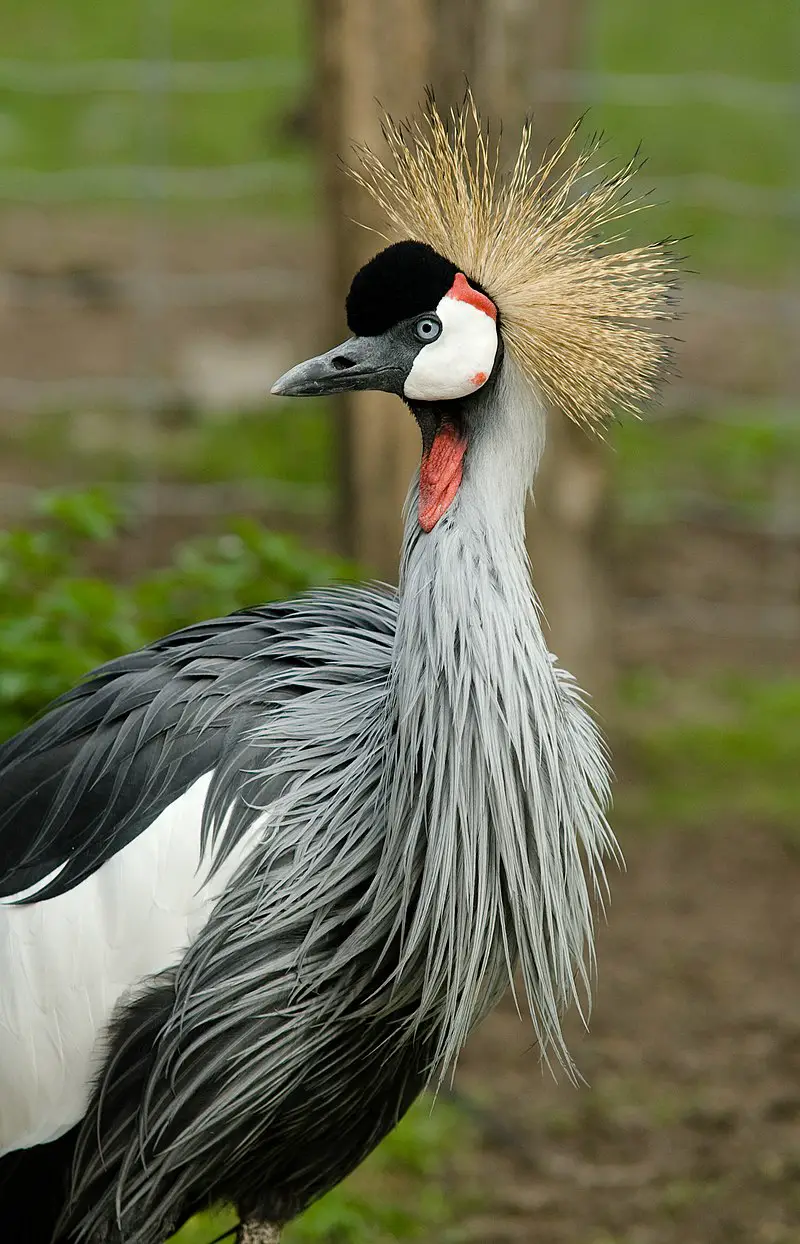
The Gruiformes is an order of birds which contains a large variety of families, both living and extinct. They are found all over the world in many different habitats, including wetlands and grasslands.
The name comes from Latin for “crane-like” due to their similar appearance to cranes. Many members of this group have long legs adapted for wading or running on land depending on the species.
They also typically have long beaks used for hunting prey such as insects and small animals like fish, frogs, and lizards.
Other traits commonly shared by these birds include strong wings with broad flight feathers that help them soar through the air when migrating or searching food sources during winter months.
In addition to these physical characteristics, some Gruiformes also possess vocalizations unique among other bird orders – making them easily recognizable even at great distances.
Scientific classification:
| Kingdom | Animalia |
| Phylum | Chordata |
| Class | Aves |
| Clade | Gruimorphae |
| Order | Gruiformes Bonaparte, 1854 |
44. Nightjars
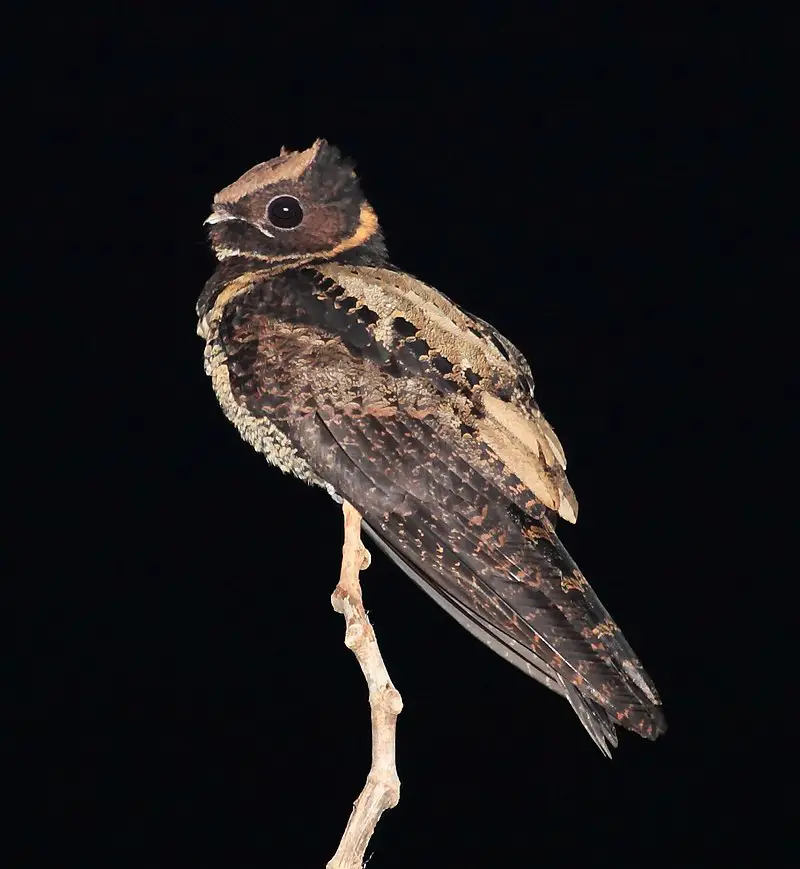
Nightjars are fascinating nocturnal or crepuscular birds belonging to the Caprimulgidae family. These medium-sized birds have long wings, short legs, and very small bills.
They can be found across many parts of the world in forests, grasslands, and scrubland habitats.
Nightjars feed on insects such as moths, beetles, crickets, and cicadas which they catch with their sharp eyesight during nighttime flights over open fields when hunting for food.
Their scientific name ‘Caprimulgidae’ is derived from an old folktale that claims these birds suck milk from goats.
In reality, though, they are harmless creatures who pose no threat to livestock whatsoever.
Nightjars make a variety of different calls ranging from whistles to chirps throughout the night – adding further mystery to this amazing species.
Scientific classification:
| Kingdom | Animalia |
| Phylum | Chordata |
| Class | Aves |
| Clade | Strisores |
| Order | Caprimulgiformes Ridgway, 1881 |
| Family | Caprimulgidae Vigors, 1825 |
45. Long-Billed Curlew
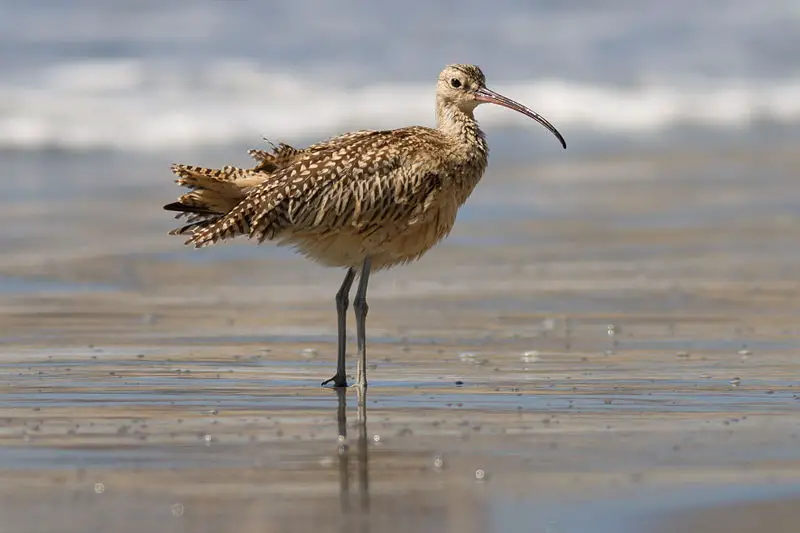
The Long-billed Curlew is an impressive shorebird, 50 to 65 cm in length and boasting a bill that can be up to 10cm long – hence its name
This species breeds in the central and western areas of North America before migrating south for winter.
Its distinctive call has earned it nicknames like “sickle bird” or “candlestick bird”. They are omnivorous, eating insects, spiders as well as plants both on land and in the water.
In addition, they also have been known to scavenge carrion from time to time.
These magnificent birds inhabit coastal regions such as mudflats, marshes, and beaches making them easy enough to spot if you know their habitat.
Scientific classification:
| Kingdom | Animalia |
| Phylum | Chordata |
| Class | Aves |
| Order | Charadriiformes |
| Family | Scolopacidae |
| Genus | Numenius |
| Species | N. americanus |
Also Featured In: Birds that Live in the Grasslands, Birds That Live In Humboldt Bay
46. MacGillivray’s Warbler
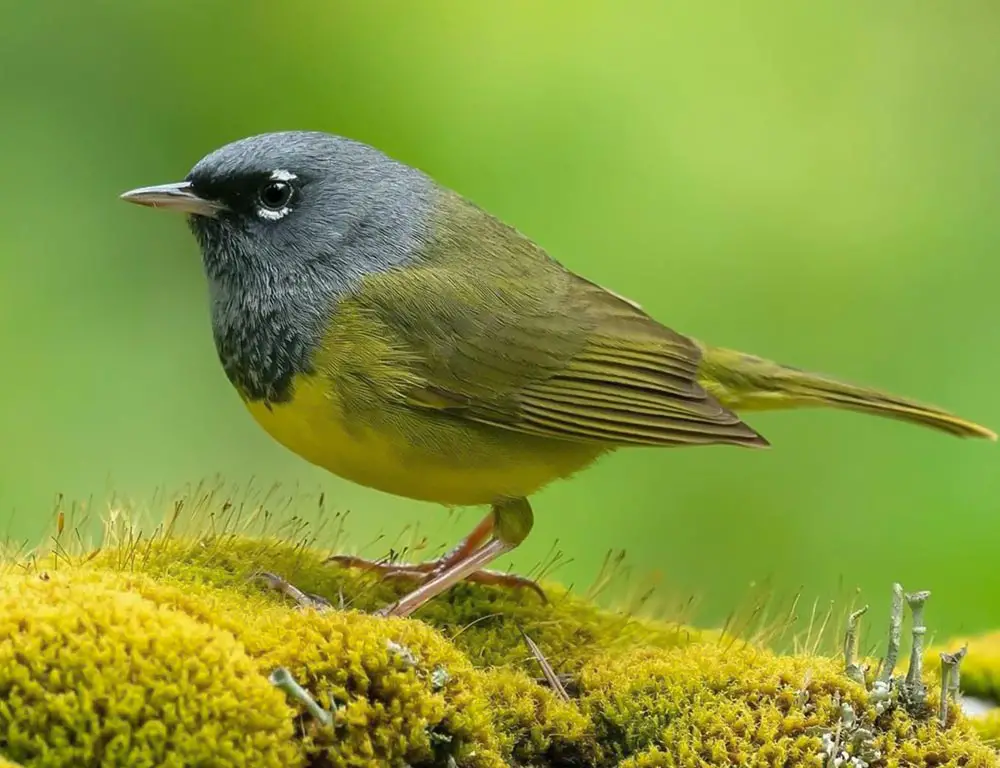
MacGillivray’s warbler is a species of New World warbler named in honor of Scottish ornithologist William MacGillivray. This bird is quite sluggish and prefers to spend most of its time on the ground, except when singing.
Its discovery was credited to John Kirk Townsend by John James Audubon. The MacGillivray’s warbler has olive-green upper parts with two yellow wing bars and white tail spots.
It also contains more grayish brown hues along its crown, neck, wings, and back than other similar species like Nashville Warblers or Common Yellowthroats.
These birds are found commonly in western North America during summer months from mid-May through late August before migrating southward for wintering grounds near Mexico region into Central America during the fall season until early springtime return migration northwards again later that year.
Scientific classification:
| Kingdom | Animalia |
| Phylum | Chordata |
| Class | Aves |
| Order | Passeriformes |
| Family | Parulidae |
| Genus | Geothlypis |
| Species | G. tolmiei |
Also Featured In: Common Yellow Birds of Idaho, Yellow Georgia Birds
47. Cassia Crossbill
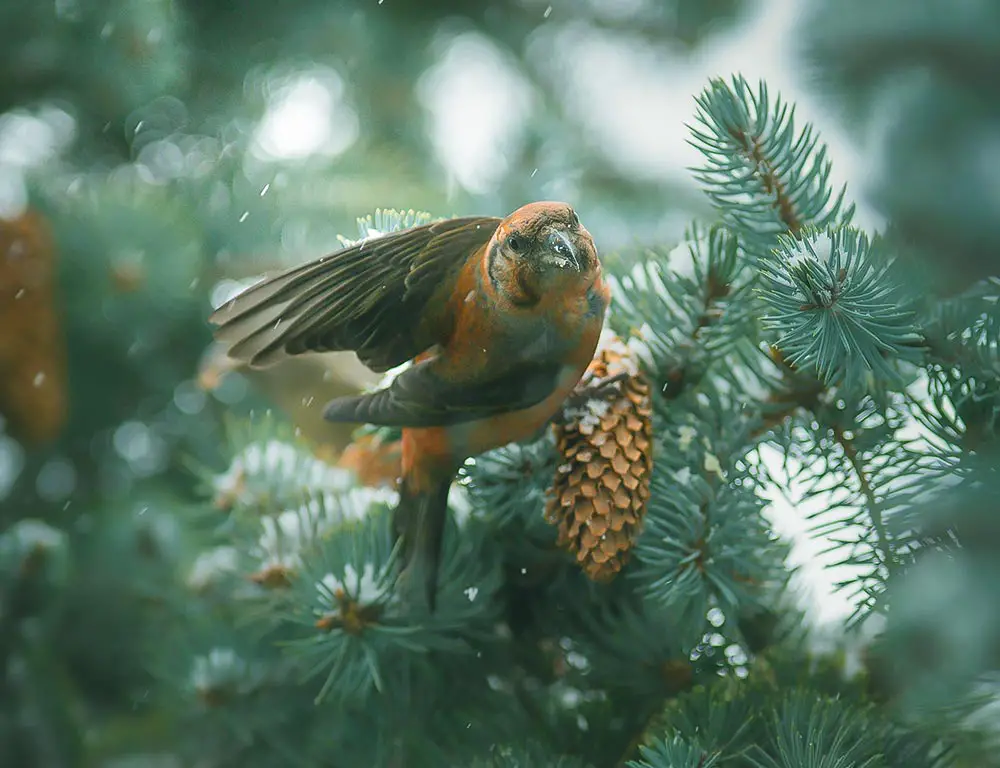
The Cassia Crossbill is a passerine bird native to the South Hills and Albion Mountains in southern Idaho.
It has an impressive beak that is adapted for cracking open pine cones and eating the seeds inside, making it perfectly suited for its habitat.
This species rarely interbreeds with other call types due to ecological speciation, meaning they are distinct from their relatives.
The male of this species boasts beautiful plumage ranging from deep reds to light oranges while both sexes sport white wing bars on either side of black wings which provide camouflage amongst conifer trees.
Scientific classification:
| Kingdom | Animalia |
| Phylum | Chordata |
| Class | Aves |
| Order | Passeriformes |
| Family | Fringillidae |
| Subfamily | Carduelinae |
| Genus | Loxia |
| Species | L. sinesciurus |
48. American Redstart
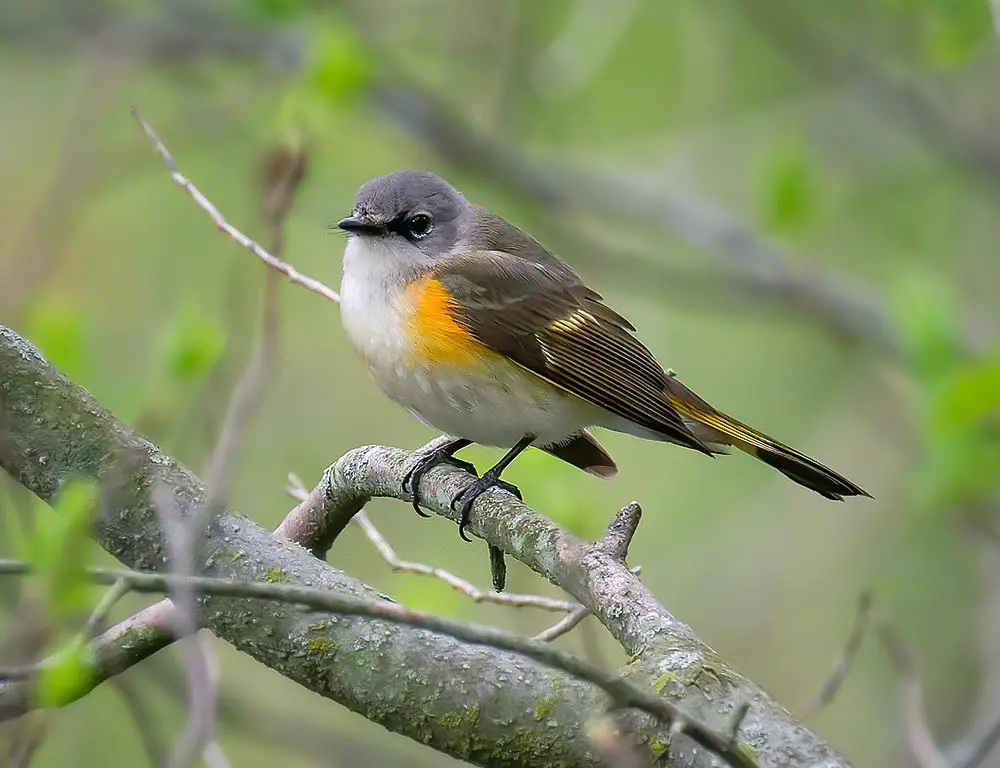
The American Redstart is a beautiful New World Warbler, first documented by Carl Linnaeus in 1758.
It has an elegant black and orange plumage that sets it apart from other birds.
The genus name Setophaga comes from the Ancient Greek words ‘sēs’ meaning moth and ‘phagos’, which means eating – referencing its insect-eating habits.
Its song is one of joy, with short repeating phrases making up their melodic tune.
They are mostly found hopping around trees on their long legs during breeding season but migrate to Central America for winter months when food sources become scarce in North America.
Scientific classification:
| Kingdom | Animalia |
| Phylum | Chordata |
| Class | Aves |
| Order | Passeriformes |
| Family | Parulidae |
| Genus | Setophaga |
| Species | S. ruticilla |
49. Tree Swallow
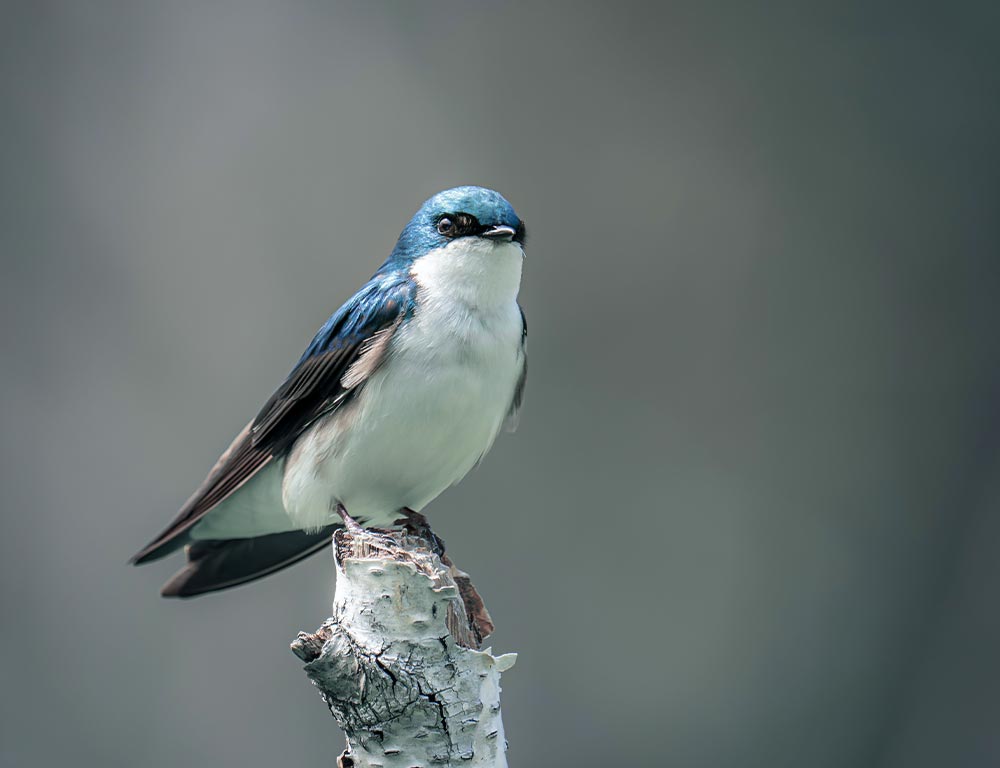
The Tree Swallow is a migratory bird of the Hirundinidae family, first described by French ornithologist Louis Vieillot in 1807. It has glossy blue-green upperparts and white underparts with iridescent violet on its throat and breast.
Its wings are blackish above with pale grey below, while its tail feathers are blackish-blue with white edges.
During breeding season they build cup-shaped nests out of grasses or twigs which are lined with animal hair or fur found near their nesting sites.
They feed mainly on insects such as flies and beetles that they catch while flying over fields or water surfaces during summer months when food is abundant for them to survive migration back southward in wintertime.
The tree swallow is an important part of our environment both aesthetically and ecologically due to its insectivorous diet helping keep pest populations low in certain areas where crops may otherwise be damaged without these birds around.
Scientific classification:
| Kingdom | Animalia |
| Phylum | Chordata |
| Class | Aves |
| Order | Passeriformes |
| Family | Hirundinidae |
| Genus | Tachycineta |
| Species | T. bicolor |